NAMES OF THE WEEK from: 2013 2014 2015 2016 2017 2018 2019 2020 2021 2023 2024 2025
28 December
Obscenity in disguise: the Uranoscopus or Stargazer
Ed. note: While re-researching the generic name Callionymus Linnaeus 1758, I found a reference that said the name “refers euphemistically to a sex-related name of the same organism” without any additional explanation. Intrigued, and suspecting that the etymology of Callionymus traces back to the ancients, I contacted our resident expert on ancient names, Dr. Holger Funk, who filed the following report. Warning: his findings are for mature audiences only!
Ancient writers were not particularly prudish. Poets filled their comedies and satires with ribald scenes and expletives. Ancient scholars, however — philosophers, historians, lexicographers and naturalists — writing for a more educated audience, shied away from calling things by their everyday names, preferring to paraphrase them, often using rhetorical devices such as euphemisms (mild or indirect substitutions for unpleasant or embarrassing words) or antiphrasis (the use of words in senses opposite to their generally accepted meanings). An example in this respect is the fish the ancient Greeks called Uranoscopus.
“Uranoscopus” is a Latinization of οὐρανός (ouranós), heaven or sky, and σκοπός (skopós), looker, contemplator or viewer. Taxonomists have called this fish Uranoscopus scaber since Linnaeus. Its common name in English is Stargazer.
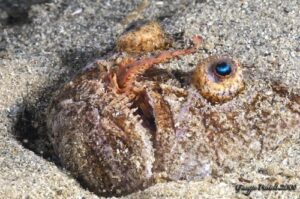
Head of a Stargazer buried in sand or gravel with reddish “fishing line” (center) to attract prey. © Giuseppe Piccioli.
Uranoscopus scaber is widespread in the eastern Atlantic, from the British Isles across North Africa to Mauritania, and in the Mediterranean and Black Seas. The average length is 22 cm, the maximum length is 40 cm. It is a bottom fish, active only at night, at depths of 15 to 400 m, where it spends most of its time buried in sand or gravel, out of sight of predators and prey. Buried in, only the eyes look out upwards, hence the name Stargazer. It has a mobile, membranous appendage on its mouth that is used to attract prey (pretending to be a kind of tubeworm ). In the Byzantine encyclopedia Suidas the Uranoscopus was also called κλέπτης (kléptēs), nocturnal trickster, because of its sneaky trapping technique. Apart from that, it was considered a common food fish in ancient times, even if its culinary quality was disputed.
The Uranoscopus had a second popular name, and here is where things get risqué. This name was “Callionymous,” a Latinization of Καλλιώνυμος (kalliṓnymos), which in turn is composed of two terms: κάλλεος (kálleos), genitive of κάλλος (kállos), beauty, and -ώνυμος (-ṓnymos), named, derived from ὄνομα (ónoma), name. Together: “having a name of beauty” or simply “having a beautiful name.”
“Callionymous” alluded to Uranoscopus (“stargazer”), a pretty name for a fish that itself isn’t particularly pretty. (It is no coincidence that Linnaeus gave it the epithet scaber, rough or scurfy.) Christians in the Middle Ages viewed the fish favorably, since anyone who gazes upward, towards Christ or God, is therefore safe from temptation. Appropriately, one of its various Greek names was also ἁγνός (agnós), the chaste one.
Neither Uranoscopus nor Callionymous suggests anything ugly, ambiguous or reprehensible. But the supposedly chaste fish led a double life, so to speak. The Greek grammarian and lexicographer Hesychius of Alexandria (5th or 6th century AD) was the first to bashfully point out this in his dictionary of unusual and obscure ancient Greek words:
“Kallionymos – a kind of fish. In a figurative sense, some have also used the expression for male and female pudenda.”
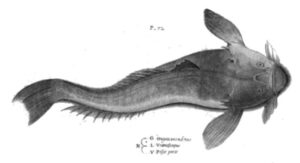
Salviani’s copper engraving of the Stargazer (1558: 196v).
Male and female pudenda? Hesychius suggests something lewd or bawdy but exercises polite restraint. Fortunately, for us, the first Renaissance ichthyologists — namely Belon (1553: 217), Rondelet (1554: 306) and Salviani (1558: 197v) — did not hold back. They listened to the colloquial language of their humble, illiterate countrymen, who talked unaffectedly. To quote Rondelet, who provided the most concise (i.e., explicit) account:
“But just as the Uranoscopus had been given a beautiful and honorable name by the ancients, so it was given an ugly and indecent name by the people of Marseilles, which an honorable woman, out of shame, scarcely dared to utter. The fish was called tapecon by these people because it seemed to resemble a pessary in shape, and raspecon because the rough head could be used to incite the female pudendum.”
In order to fully appreciate Rondelet’s explanation, one needs to know that pessaries were used as a gynecological aid in ancient times, just as they are used nowadays. The term pessary comes from the Greek πεσσός (pessós) and Latin pessum or pessus, a plug of wool or lint. Apparently, such pessaries could also be used as sex toys. And if common means of joy were not at hand, they would be replaced with substitutes, even, we are told, with a rough-headed fish like the Uranoscopus. In view of the testimonies of different provenance, it would be too easy to dismiss this as just male fantasy.
The colloquial terms Tapecon and Raspecon likewise need explanation. According to linguists Behrens & Haust (Wortgeschichtliches, 1909: 151–152), the two terms originated through a a transformation and interchange of letters and syllables, a so-called “reciprocal metathesis,” typical for Romance languages. In the present case it took place in two steps: the Latin name uranoscopus first became the Frenchized uranoscopon, then later was mangled once more to raspecon, tapecon and other similar expressions, with the ichthyological origin of the words now lost and unrecognizable.
Callionymous, by virtue of its being a synonym for Uranoscopus, also became a term with a sexual connotation. Indeed, “having a beautiful name” is a lovely euphemism for body parts that should not, in polite company, be named.
Ed. note: Today, Uranoscopus Linnaeus 1758 refers to stargazers (Uranoscopidae) and Callionymus Linnaeus 1758 refers to an unrelated genus, dragonets (Callionymidae). Linnaeus, believing that stargazers and dragonets were closely related, followed his colleague Peter Artedi in adopting both ancient names, selecting Uranoscopus for the fishes with the upturned eyes and Callionymus for the dragonets. Whether Linnaeus was aware of the hidden meanings behind the names is unknown.
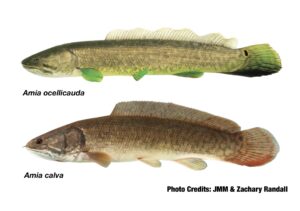
Richardson’s selection of the name Amia ocellicauda was percipient since this bowfin’s caudal ocellus (eyespot) is more pronounced in males than that of the nominate species, Amia calva.
21 December
Amia ocellicauda Richardson (not Todd) 1836
Ichthyologists have long suspected that the Bowfin Amia calva — the sole surviving member of a family of fishes (Amiidae) that populated fresh and marine waters 135-195 million years ago — represents two or more extant species. Now researchers have confirmed this suspicion. Using genomic data in conjunction with several different phylogenetic and population genetic analyses, they demonstrated that individuals from the Great Lakes to the Mississippi River basin, west of the Appalachian Mountains, represent Amia ocellicauda (first described in 1836) rather than the widely recognized A. calva, now restricted to the Pearl River in Louisiana and Mississippi to the Florida Peninsula, and rivers draining to the Atlantic Ocean in Georgia, South Carolina, North Carolina and Virginia.
You can read their paper here.
Unfortunately, the authors perpetuated a mistake in the authorship of the name. They date Amia ocellicauda to “Todd in Richardson 1836,” meaning that Todd named the bowfin within a publication written or edited by Richardson published in 1836. Actually, while Todd provided a descriptive account, the name was proposed and made available by Richardson. Hence, authorship of Amia ocellicauda should be “Richardson 1836” or “Richardson (ex Todd) 1836.”
The authors of the paper did not originate this mistake. It had become entrenched in the literature and was given incorrectly in Eschmeyer’s Catalog of Fishes. As I was adding Amia ocellicauda to ETYFish I noticed the error and contacted Ron Fricke, one of ECoF’s editors. The authorship of the name has been corrected in their database.
Richardson was Scottish surgeon-naturalist John Richardson (1787‒1865), the author of the fish section of “Fauna Boreali-Americana,” an important early work on the fishes of Canada, western North America and the Arctic circle. He collected many of the fishes he described himself. But he also relied on the “exertions of others” (to use his words). The “Todd” in the case of A. ocellicauda was “Mr. Todd, surgeon of the Naval depôt,” a Royal Navy depot at Lake Huron, the type locality. Richardson did not supply Todd’s first name but I have found several records indicating that a “C. C. Todd,” a medical officer with an interest in natural history, lived or was stationed at Penetanguishene, Ontario, on the shores of Lake Huron.
Richardson wrote: “Mr. Todd sent me a notice of a Lake Huron fish, named locally Poisson de Marais [Marsh-fish]. It is speared by the Indians in the rushy shallows which it frequents, but is seldom eaten by the settlers. A specimen which Mr. Todd prepared, being unfortunately destroyed by vermin, never reached me, but his short description corresponds with the characters of the genus Amia, though the gill-rays are fewer than in the Carolina species.”
Richardson quoted Mr. Todd’s “in lit.” description of the bowfin and gave him credit for it. But Mr. Todd did not supply a Latin or scientific name. Since it was Richardson who coined “ocellicauda” — referring to the bowfin’s prominent ocellus or eyespot on the upper caudal-fin base of males — and affixed it to Mr. Todd’s description, that makes him, not Todd, the author of the name.
Richardson followed this format several times in the same publication in which Amia ocellicauda was proposed. For example, the following fishes were all named by Richardson but based, in part, on unpublished descriptions written by surgeon-naturalist Meredith Gairdner (1809-1837) of the Hudson’s Bay Company (a fur trading company):
White Sturgeon, Acipenser transmontanus
Northern Pikeminnow, Ptychocheilus oregonensis
Redside Shiner, Richardsonius balteatus
Eulachon, Thaleichthys pacificus
Cutthroat Trout, Oncorhynchus clarkii
Prickly Sculpin, Cottus asper
Richardson returned the favor by naming the Columbia River Redband Trout (now Oncorhynchus mykiss gairdneri) after Gairdner. Too bad he didn’t do the same for Mr. Todd.
14 December
Unavailable names (at least for now)
In order for a zoological name to be considered “available” — that is, permanently affixed to a taxon and available for use by other zoologists — it must be proposed in certain ways as required by the International Commission of Zoological Nomenclature (ICZN). These rules are explained in my essay, “Fish-centric Guide to Zoological Nomenclature.”
One of the more recent rules was established to deal with the rapid proliferation of electronic publications. Such publications are now regulated by amendments of ICZN Articles 8, 9, 10, 21 and 78. If published electronically (after 2011 only), either for free or behind a paywall, a new-taxon description must be presented in a fixed graphical format (i.e., non-HTML, usually a PDF), with the date of publication stated in the work and the work itself registered in the Official Register of Zoological Nomenclature (ZooBank) with evidence of such registration (a Life Science Identifier, or LSID number) appearing in the text. Descriptions that are printed on paper and distributed or made available for purchase do not require ZooBank registration (but is strongly encouraged nevertheless).
With printing and mailing costs on the rise, concerns over deforestation and the unnecessary use of paper, and the near universal acceptance of PDFs as a convenient scholarly format, many printed journals are suspending hard-copy publication and going all-digital. One such publication is aqua, International Journal of Ichthyology, published by explorer and ornamental-fish wholesaler and supplier Heiko Bleher. In 2021, aqua (not a typo, the journal’s name is all lower-case) quietly announced it was suspending the printed version:
“New Subscription Notice starting with volume 28: Do [sic] to pandemic times we had severe problems worldwide and printing cost went up sky-high, therefore we were forst [sic] to publish only on-line since 2021 but everything else remains same …”
Unfortunately, none of the new-taxon descriptions in all aqua issues after v. 27 (no. 1) (April 2021) have ZooBank registrations. Without ZooBank registration, new taxa published in electronic-only papers are considered “non-existent.” This rule affects 15 new species and one new subgenus recently proposed in aqua. Most of these I’ve already entered into the ETYFish Project not realizing that the journal had ceased hard-copy publication. They are:
A flying barb (Danionidae) from India: Esomus nimasowi Abujam, Gogoi, Das, Das & Biswas 2021, in honor of Gibji Nimasow, Rajiv Gandhi University (Arunachal Pradesh, India), for his “constant encouragement and interest in fishery related works”
A headstander (Anostomidae) from Bolivia: Megaleporinus prochiloides Roberts 2021, –oides, having the form of: referring to its greatly enlarged mouth and lips, strongly resembling those of Prochilodus (Prochilodontidae)
A torrent catfish (Amblycipitidae): Amblyceps motumensis Abujam, Tamang, Nimasow & Das 2022, –ensis, Latin suffix denoting place: Motum River, Siang River drainage, Arunachal Pradesh, India, type locality
Two sand-dwelling gobies (Gobiidae) from the tropical western Pacific: Hazeus ammophilus Allen & Erdmann 2021, ammos, sand; philo, to love, referring to its predilection for sand-bottom habitats; and Hazeus profusus Allen & Erdmann 2021, abundant or profuse, referring to its abundance on sand-bottom habitats [these names made available in November 2023]
Three damselfishes (Pomacentridae): Pomacentrus novaeguineae Allen, Erdmann & Pertiwi 2022, of New Guinea, its main area of occurrence, especially from its northern side and western extremity, where coral reefs are well developed; Pomacentrus umbratilus Allen, Erdmann & Pertiwi 2022, Latin for “of the shade,” referring to its habit of sheltering in the shady recesses of the reef, especially under ledges; and Pomacentrus xanthocercus Allen, Erdmann & Pertiwi 2022, xanthus, yellow; cercus, tail, referring to bright-yellow caudal fin with yellow hue extending forward onto caudal peduncle [these names made available in October 2023]
Three rivuline killifishes (Rivulidae) from Brazil: Anablepsoides falconi Nielsen, Hoetmer & Vandenkerkhove 2022, in honor of Francisco Falcon, musician, photographer and environmentalist; he is also a “great friend” and “excellent” killifish breeder who has developed new breeding techniques and has helped many Brazilians enter the killifish hobby (D. Nielsen, pers. comm.); Anablepsoides katukina Nielsen, Hoetmer & Vandenkerkhove 2022, named for the Katukina, an indigenous group inhabiting the Rio Juruá drainage, Amazon basin, Acre State, Brazil, where this killifish occurs; and Laimosemion anitae Nielsen, Hoetmer & Vandenkerkhove 2022, in honor of Anita Hoetmer, wife of the second author (who is also its discoverer) [these names made available in August 2023]
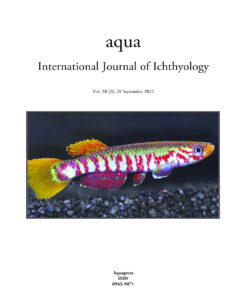
Four new fish taxa are described in this recent issue of aqua, but the names are not yet available.
The latest issue of aqua (cover shown here) includes the descriptions of four additional new taxa (three species, one subgenus), all missing ZooBank registration. All of these descriptions are important contributions to the scientific record, written by serious, competent ichthyologists. So it’s unfair that their efforts now languish in the nomenclatural limbo of “unavailable” names.
In addition to these aqua papers, I have three more from three other online-only journals in my “No ZooBank/Unavailable” folder, with the descriptions of six putative new species.
Missing ZooBank registration numbers is not unique to fishes. It’s a problem affecting the descriptions of other taxonomic groups as well, involving both well-established journals, serious “open access” journals, self-published journals, and a growing number of predatory journals in which the authors pay to have their papers published with little or no peer review. It seems that many editors and publishers of electronic-only publications are not aware of — or simply do not care about — the ZooBank requirement.
The editors of Eschmeyer’s Catalog of Fishes have alerted the editor of aqua, Paolo Parenti, about the problem. They recommended that the journal publish a follow-up paper that includes ZooBank registrations (which would change the availability dates for the above-mentioned taxa from 2021 and 2022 to at least 2023). Until such time, these names remain “non-existent” for nomenclatural purposes.
Technically, I should delete these taxa from ETYFish. But that’s extra work, not to mention the extra work of reinstating them if and when the ZooBank requirement is fulfilled. Chances are the names of these taxa will, despite their unavailability, make their way into the ichthyological literature, bibliographic indices and various websites anyway. I will add asterisks to their ETYFish entries, but it is not a priority. There are plenty of validly published new fish taxa that deserve my attention first.
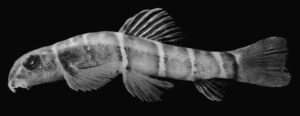
Barbucca diabolica, holotype, gravid female, 23.2 mm SL. Photo by Tyson R. Roberts. From: Roberts, T. R. 1989. The freshwater fishes of western Borneo (Kalimantan Barat, Indonesia). Memoirs of the California Academy of Sciences No. 14: i–xii + 1–210.
7 December
Barbucca diabolica Roberts 1989
It’s always nice to tie up a loose end in the explanation of a name.
With just two species, the family Barbuccidae is the smallest loach family (actually, tied with Ellopostomatidae, also with two species). The type species, Barbucca diabolica, representing both a new genus and species, was described by Tyson R. Roberts in 1989. (In 2012, Maurice Kottelat determined that, due to its distinctive morphology and position outside any other loach sublineage, Barbucca warranted its own family.)
Barbucca diabolica is a small loach, reaching just 2.3 cm. It’s found in small forest streams and backwaters of indonesia. Some references call it a “Scooter Loach” for how its “scoots” instead of swims, with its belly almost always in contact with an object (e.g., rock, tree branch) or substrate as it wriggles and climbs (sometimes upside down). Other references call it the “Fire-eyed Loach” because of its blood-red eyes.
Roberts named the genus Barbucca — barba, Latin for beard or barbel, and bucca, Latin for cheek — referring to a patch of tubercles found on the cheeks of males. The specific epithet is Latin for devilish, from the Greek diabolikós (διαβολικός), referring, per Roberts, to the “glowing red eyes and spiked tail characteristic of the species.”
The “glowing red eyes” reference is obvious. The “spiked tail” reference is not. As you can see from the photo that accompanied the original description (shown here), there is nothing “spiked” about the tail. Nor is the tail mentioned in Roberts’ description. One aquarium website says the name is inspired in part by the loach’s “forked tail,” but the tail is not noticeably forked. It appears truncated or emarginate to me.
I asked Tyson Roberts via email what he deemed “spiked” about the tail. He is retired now, living in Bangkok, and said he didn’t have access to the description. “But supposedly you have access to it,” he wrote, “and the answer to your question should be obvious from reading it.”
I sent Dr. Roberts a PDF of his description and kindly pointed out that the answer to my question was not at all obvious. Receiving the PDF apparently jogged his memory because he quickly replied:
“Yes, the name diabolica refers to the red eyes and the tubercles on the caudal peduncle, present in males and females, that are large are sharp-pointed (although sharp pointed or spike-like is not mentioned in the text).”
Knowing precisely what the fish’s name means is not all that important in the scheme of things. But I enjoy chasing down such arcana. In this case, my curiosity about the fish’s name brought to light a heretofore unnoticed detail about its distinctive morphology.
30 November
Why are some sharks named after dogs and others after cats?
EDITOR’S NOTE: This week’s entry is written by Holger Funk, a Greek and Latin scholar interested in ichthyological writings dating from ancient times to the Renaissance. He has been helping The ETYFish Project improve its coverage of Latin and Greek (especially Greek!) names and etymologies. Along the way, he has made some fascinating and useful discoveries. This “Name of the Week” is one of them. Dr. Funk has declined any formal credit, so let me take this opportunity to acknowledge and thank him for his valuable “behind-the-scenes” contributions to The ETYFish Project.
Some sharks are called “dogfishes.” Others are called “catsharks.” Allusions to both cats and dogs appear in a handful of scientific names. The deepwater catshark (Pentanchidae) genera Bythaelurus, Cephalurus and Halaelurus are based on the Greek noun aílouros (αἴλουρος), meaning cat. Despite its common name, the specific epithet of the Small-spotted Catshark Scyliorhinus canicula is derived from the Latin word for dog (canis). How is it that sharks have been named for both cats and dogs? The “dog” designation dates to the ancient Greeks. The “cat” designation began in the Renaissance. And despite what the venerable Oxford English Dictionary and otherwise dependable ichthyological references (e.g., earlier versions of The ETYFish Project) tell you, catsharks are not named for their cat-like eyes.
The ancient Greeks subsumed sharks under the collective term “dog” (κύων, kýōn) or “sea-dog” (κύων ἡ θαλαττία, kýōn hē thalattía). Like the Greeks, the Romans used the term canis marinus, “sea-dog.” Unlike the comparable English vernacular “dogfish,” which usually applies to smaller sharks, the Greek and Latin terms encompassed larger sharks as well. What’s important to note here is that from ancient times (Homer) to the late Byzantine (ca. 1400), sharks were only associated with dogs, never with cats.
Ancient sea-dogs did not comprise a clearly defined group, yet we know from the works of two Greeks —Aristotle and Oppian (Halieutica, “On Fishing”) — the names of nine species that we can identify more or less well with today’s genera and species. Of particular interest is a species Aristotle calls σκύλιον (skýlion) and Oppian synonymously calls σκύμνος (skýmnos). Both names denote a young animal of different quadrupeds, especially a young dog or whelp. By assigning this name to small sharks, the ancients were saying that small sharks were, in a metaphorical sense, small dogs or whelps compared with larger sharks. Interestingly, both skýlion and skýmnos applied to a young cat or kitten as well, providing an etymological foundation for the curious fact that sharks have been, and still are, referred to as both dogs and cats.
The Romans (mainly Pliny and Ovid), unlike the Greeks, were not very creative when it came to naming fishes. Mostly they adopted Greek names either by transliterating them letter by letter according to the Latin alphabet, but sometime they translated the Greek name into Latin. This happened with the Small-spotted Catshark. Here they translated the aforementioned Aristotelian name σκύλιον as canicula, young dog or puppy (diminutive of canis, dog). However, they were a little creative at least once, using the term catulus alongside canicula, which has nothing to do with cats despite how it sounds (Latin for cat is feles). In fact, catulus is another diminutive for a young animal, particularly a young dog (per Walde & Hofmann, Lateinisches etymologisches Wörterbuch, vol. I, 1938, p. 183).

Fig. 1. Rondelet, Libri de piscibus marinis (1554: 383), French version L’histoire entiere des poissons (1558: 300): Latin Canicula saxatilis, called Chat rochier or Catto rochiero (‘Rock cat’) in southern France (= Scyliorhinus stellaris, Nursehound).
These two designations, canicula and catulus, entered scholarly discourse in the 16th century when two pioneers of the burgeoning discipline of ichthyology, the Frenchman Guillaume Rondelet and the Italian Hippolito Salviani, cited the classical Greek and Latin names in their accounts. They also cited the vernacular names of their respective home countries. This is when “cat” first enters the shark lexicon. In France, according to Rondelet (1554), the scyliorhinid “Canicula saxatilis” (=Scyliorhinus stellaris, Nursehound) is known by the local name Chat rochier (“Rock cat”) (Fig. 1). In Rome, according Salviani (1558), “Catulus” (=Scyliorhinus canicula, Small-spotted Catshark), goes by the popular name Pescie Gatto (“Cat fish”) (Fig. 2).

Fig. 2. Salviani, Aquatilium animalium historiae (1558: 137v): Greek Σκύλιον. Latin Catulus, called Pescie Gatto (“Cat fish”) in Rome (= Scyliorhinus canicula, Small-spotted Catshark).
Based on the accounts of Rondelet and Salviani, both the Latin designations and the local vernaculars became firmly established in the ichthyological literature over time. The breakthrough came exactly 200 years later with the 10th edition of Linnaeus’ Systema naturae of 1758, the official starting point of modern zoological nomenclature. Linnaeus knew about Rondelet’s and Salviani’s accounts thanks to the large inventory of ancient fish names compiled by his Swedish compatriot and friend Peter Artedi. Consequently, Linnaeus formally proposed the names Squalus (now Scyliorhinus) canicula and Squalus catulus (the latter now a junior synonym of the former).
The French and Italian “cat” vernaculars eventually made their way into English. In 1812, Thomas Pennant was one of the first to render σκύλιον, canicula and catulus as “Cat fish” in his British Zoology: IV. Fishes (p. 148).
If one surveys the ancient Greek and Latin names, it becomes clear that canine semantics dominated at all times. But why dogs? Were the ancients comparing the light grayish coloring of some sharks to that of dogs? Or was “dog” a derogatory term since the ancients considered sharks inferior in every respect (harmful to humans and unpalatable except as food for the poor)? Could dog be a reference to the voracious, pack-like feeding behavior of sharks in a feeding frenzy? Whatever the explanation, an association with cats is not documented in neither Greek nor Latin. The alleged “cat-like” eyes of certain sharks that have been brought into play can also be ruled out. Palombi & Santarelli (Gli animali commestibili dei mari d’Italia, Milan 2001: 220–222), for example, have noted that in Italian both Scyliorhinus canicula with its relatively large eyes and Scyliorhinus stellaris with relatively small eyes equally are named gatto (kitten). It is more likely that in the national languages that developed from Latin, such as Italian and French, a vulgarization of catulus took place, with the original meaning of “dog” fading more and more until being replaced by the meaning “cat.” All this happened quite unconsciously and without any objective reasons.
The “cat” name for certain sharks is therefore to be regarded as a misunderstanding and misapplication. “Catulus” has nothing to do with cats, and likewise sharks have next to naught in common with cats.
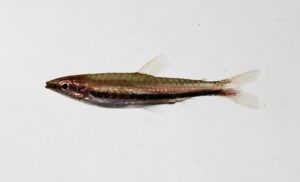
Nannostomus marilynae. Photo by Clinton & Charles Roberston. Courtesy: Wikipedia.
23 November
Marilyn Weitzman (1926-2022)
Earlier this month I learned that Marilyn Weitzman passed away during the summer at the age of 96. News of her death has been hard to come by. No online obituary. Nothing on Facebook. No retrospectives or appreciations. At least none that I could find.
Marilyn Weitzman was the wife of legendary Smithsonian ichthyologist Stanley H. Weitzman (1927-2017; see NOTW, 22 Feb. 2017). Trained in landscape architecture, she became an accomplished ichthyologist herself, specializing in the pencilfishes of the characiform family Lebiasinidae. I once visited the Weitzman lab and it was filled with small aquaria where she bred and raised these small but elegant fishes. Both Weitzmans were equally at home hanging out with members of their local aquarium club (the Potomac Valley Aquarium Society) as they were with fellow ichthyologists. In 2002, I had the pleasure of co-judging the PVAS fish show with them. They were kind and gracious to a fault.
Marilyn learned ichthyology by typing her husband’s papers. While working on a revision of the pencilfishes, Stan asked Marilyn to help. He had done one genus, Nannostomus, but Marilyn could do the rest. It was a small group and would be fairly easy, Stan assured her. “Famous last words,” Marilyn laughed.
Despite her interest in pencilfishes, the two species that Marilyn described or co-described were from other characiform families. In 1985, she described the Veilfin Tetra Hyphessobrycon elachys from eastern Paraguay. Its name, Greek for small, refers to its small adult size, less than 16.6 mm SL, making it one of the smallest known tetras. A year later she collaborated with Smithsonian colleague Richard P. Vari to describe another characid, Astyanax (now Jupiaba) scologaster, from the Río Negro of Venezuela. The name is a combination of skolos, a thorn or pointed object, and gaster, belly, referring to the “exserted spinous pelvic bones” on its ventral surface.
Three of Marilyn’s beloved pencilfishes have been named in her honor:
Nannostomus marilynae Weitzman & Cobb 1975 – This pencilfish (shown here) from the Rio Negro of Brazil and Colombia was named by Stanley Weitzman and J. Stanley Cobb (later a renowned lobster biologist). Stanley honored his wife, stating how Marilyn “has long shared his appreciation for the delicate beauty of members of the genus Nannostomus.”
Lebiasina marilynae Netto-Ferreira 2012 – Brazilian ichthyologist André L. Netto-Ferreira named this pencilfish, described from the headwaters of the rio Curuá in Serra do Cachimbo, Pará, Brazil. Marilyn was honored for devoting her career to the study of fishes of the families Lebiasinidae and Characidae
Pyrrhulina marilynae Netto-Ferreira & Marinho 2013 – Marilyn was honored for her assistance to both authors in their studies of the family Lebiasinidae. This pencilfish occurs in the Rio Tapajós and Rio Xingu of Mato Grosso, Brazil.
Stanley and Marilyn Weitzman had known each other since third grade. They married in 1948 and remained partners in love, family and fishes until his passing in 2017.
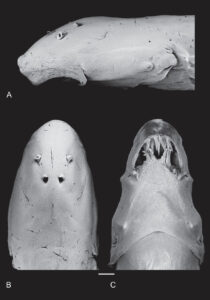
Paracanthopoma truculenta, paratype, SEM images of head. (A) Lateral; (B) Dorsal; (C) Ventral. Scale bar = 500 μm. From: de Pinna, M. C. C., & Dagosta, F. C. P. (2022). A taxonomic review of the vampire catfish genus Paracanthopoma Giltay, 1935 (Siluriformes, Trichomycteridae), with descriptions of nine new species and a revised diagnosis of the genus. Papéis Avulsos De Zoologia, 62, e202262072.
16 November
Bloodsucking demons: 9 new species of “candiru”
Along with vampire bats, hematophagous catfishes of the trichomycterid subfamily Vandelliinae are the only jawed vertebrates that feed exclusively on blood as adults. These South American fishes — popularly known as “candirus” — are infamous for their occasional penetration of human urethras, a fact that has generated a veritable cottage industry of books, articles and TV documentaries, some serious, many sensationalistic. Last week, Brazilian ichthyologists Mário de Pinna and Fernando Cesar Paiva Dagosta published a taxonomic revision of the vandelliine genus Paracanthopoma, in which they described nine new species. The names of all nine species evoke, in one way or another, the feelings of fear, dread and discomfort these “demonic” catfishes elicit in humans.
Paracanthopoma ahriman — named for Ahriman, Persian name of Angra Mainyu, the maker of snakes, demons and all things evil from a human standpoint (thus, presumably also candirus) in the Zoroastrian religion, approximately equivalent to, and probably historical ancestor of, the devil in Abrahamic mythology
Paracanthopoma capeta — Portuguese vernacular (probably a combination of capa, cape, and ‑eta, a diminutive suffix) meaning the devil (i.e., an evil fish from a human standpoint)
Paracanthopoma carrapata — feminine declension of carrapato, Portuguese name for bloodsucking ticks in general, alluding to this fish’s hematophagous habits
Paracanthopoma daemon — Latinized form of the Greek daimon, “supernatural entities hierarchically between gods and mortals, including inferior divinities and ghosts of some dead men,” i.e., a demonic fish from a human standpoint
Paracanthopoma irritans — Latin for irritating, taken from the name of the human flea, Pulex irritans, also a hematophagous species
Paracanthopoma malevola — Latin for ill-disposed or inimical, i.e., an unfriendly fish from a human standpoint
Paracanthopoma satanica — derived from the Hebrew verb satan, meaning literally “to oppose” but commonly used to refer to an enemy or the devil (i.e., an unfriendly or evil fish from a human standpoint)
Paracanthopoma truculenta — Latin for harsh, cruel or brutish, alluding to its size, the largest species of this hematophagous genus
Paracanthopoma vampyra — Latinization of the Slavic wampir, a blood-sucking ghost or demon, referring to its hematophagous habits
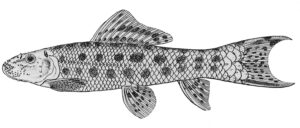
Gyrinocheilus pennocki. From: Fowler, H. W. 1937. Zoological results of the third De Schauensee Siamese Expedition. Part VIII. Fishes obtained in 1936. Proceedings of the Academy of Natural Sciences of Philadelphia v. 89: 125-264.
9 November
Gyrinocheilus pennocki (Fowler 1937)
American ichthyologist Henry Weed Fowler (1878-1965) had the curious habit of naming fishes from foreign countries after Americans who helped him acquire fishes from the United States. Gyrinocheilus pennocki is one example. Fowler named this algae eater (Gyrinocheilidae) from Thailand in honor of the late Charles J. Pennock (1857-1935) of Kennett Square, Pennsylvania, USA. Pennock, to whom Fowler was indebted for specimens of various North American fishes, was a businessman (insurance, real estate), local politician and Justice of the Peace. He was also a serious bird enthusiast, serving as President of the Delaware Valley Ornithological Club (DVOC), one of the oldest ornithology organizations in the United States.
In May 1913, Pennock’s life took a bizarre, delusional turn. After a DVOC meeting, instead of taking the train home to his wife and family, he disappeared. His family was baffled. He had wandered off once before, explained at the time as memory loss due to “inflammatory rheumatism,” but this time was different. He remained missing for over six years.
 Pennock made his way to St. Marks, Florida, shaved his beard, and began a new life under the name of John Williams. He worked as a bookkeeper for a local fishing company and even became a prominent citizen, serving as County Commissioner and a notary public. He also continued to collect birds and bird eggs, and to publish articles on his ornithological studies, all under his new name. His ornithological work led to his discovery. In September 1919, “Williams” submitted an article to “The Auk” (now called “Ornithology”), the official publication of the American Ornithological Association. The editor, Witmer Stone, had known Pennock and edited his earlier articles. Based on handwriting and writing style, Stone thought that John Williams and Charles Pennock could be the same person but dismissed the idea as ridiculous. Two months later, Stone mentioned the possibility to Richard J. Phillips, Pennock’s brother-in-law. In December, Phillips traveled to St. Marks, Florida, found Pennock, and persuaded him to return home, which he did, wearing the same suit he had worn the day he disappeared. Pennock reunited with this wife, resumed activities with the Delaware Valley Ornithological Club and some of his business interests.
Pennock made his way to St. Marks, Florida, shaved his beard, and began a new life under the name of John Williams. He worked as a bookkeeper for a local fishing company and even became a prominent citizen, serving as County Commissioner and a notary public. He also continued to collect birds and bird eggs, and to publish articles on his ornithological studies, all under his new name. His ornithological work led to his discovery. In September 1919, “Williams” submitted an article to “The Auk” (now called “Ornithology”), the official publication of the American Ornithological Association. The editor, Witmer Stone, had known Pennock and edited his earlier articles. Based on handwriting and writing style, Stone thought that John Williams and Charles Pennock could be the same person but dismissed the idea as ridiculous. Two months later, Stone mentioned the possibility to Richard J. Phillips, Pennock’s brother-in-law. In December, Phillips traveled to St. Marks, Florida, found Pennock, and persuaded him to return home, which he did, wearing the same suit he had worn the day he disappeared. Pennock reunited with this wife, resumed activities with the Delaware Valley Ornithological Club and some of his business interests.
The New York Times (1 Jan. 1920) reported on Pennock’s return: “Suffering from a nervous disease, he had become victim of a delusion that he had to leave every one and bury himself. He was discovered … buried in the forests of Florida where his only solace in his self-enforced exile was the companionship of the birds.”
Pennock died from a heart attack at his home in Kennett Square, Pennsylvania, on 20 August 1935.
When Pennock disappeared, The New York Times (20 May 1913) published a brief “missing persons” notice that contained a rather stunning statement. According to the Times, “Twenty-five men, several of them leaders in business circles in Philadelphia and its vicinity, have disappeared within the past few months, and in only a few cases have they been found.”
Was there a sinister or conspiratorial reason for Pennock’s disappearance?
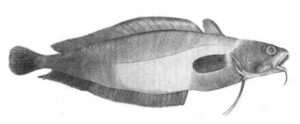
Salviani’s illustration of Phycis phycis, which he called Callarias. From: Salviani, H. 1558. Aquatilium animalium historiae liber primus, cum eorumdem formis, aere excusis. Rome. viii + 256 pp.
2 November
Phycis phycis – a double misnomer
Written with Holger Funk, in memory of Hippolito Salviani, a pioneering ichthyologist who died 450 years ago
The Forkbeard Phycis phycis (Linnaeus 1766) is a nocturnal, deeper-water cod-like fish (family Phycidae, order Gadiformes) from the Mediterranean, the Azores, and the Northeast Atlantic from Morocco to Cape Verde. Its scientific name is a Latinization of the Greek φῦκος (phū́kos), meaning seaweed. The ancient Greeks associated the phycis with wrasses (Labridae), which live amidst seaweed and build their nests from it. Wrasses were therefore rightly called seaweed fishes. Phycis phycis, on the other hand, have nothing to do with seaweed, and so its name is biologically incorrect.
How did this double misnomer come about?
The first naturalist to accurately describe and illustrate the Forkbeard (long before Linnaeus gave it its official name) was the Italian Hippolito Salviani (1514–1572) in his work Aquatilium animalium historiae of 1558. Salviani not only introduced the species to science, he also recognized two essential points: 1) that in Rome, where he lived, a kind of cod was popularly called Fico, a name linguistically and etymologically unrelated to the Phycis of antiquity (Fico is a transfer from the fruit fig, Italian fico, Latin ficus, since the flesh of both is said to be similarly soft); and 2) Salviani recognized that the fish was not a wrasse but a cod. He therefore named the fish Callarias, a term applied to cods since ancient times. The name Phycis, by contrast, Salviani reserved for Serranus cabrilla or Comber, which in fact also lives in seaweed, specifically in Neptune grass or Mediterranean tapeweed (Posidonia oceanica).
In the 1720s, Peter Artedi trawled through ancient and Renaissance texts for his systematic worldwide revision of fishes. He briefly reported (Ichthyologia, 1738, pars IV: Synonymia, p. 111) on Salviani’s important findings about Callarias, but he seems to have misread Salviani’s rather opaque, hyperscholarly Latin-Greek prose. In so doing, he erroneously believed that three fishes mentioned in Salviani’s account — the Phycis of antiquity (a wrasse), “Tenca marina” (the Roman equivalent of Phycis), and Callarias — were all the same species. Although Artedi agreed with Salviani that the fish was a cod, he selected the seaweed/wrasse name Phycis to represent it.
The name has stuck.
After Artedi’s accidental death in 1735, his friend and literary executor Carl Linnaeus edited and published Artedi’s unpublished manuscripts in 1738. When Linnaeus later dealt with the Forkbeard Phycis himself (Systema naturae, 12th edition, vol. 1, Stockholm 1766, p. 442), using his binominal (genus-species) naming system, he called it Blennius phycis, borrowing Artedi’s name for the genus as the name for the species. Since Linnaeus believed the Forkbeard is a blenny, he placed it in the genus Blennius.
When Johann Julius Walbaum (1724–1799) updated and republished Artedi’s Ichthyologia in 1792, he made Artedi’s pre-Linnaean names (including Phycis) nomenclaturally available for future taxonomists. In 1933, Italian ichthyologist Umberto D’Ancona realized that Blennius phycis — not a blenny — needed a new generic name. Since Walbaum’s account of Artedi’s Phycis was the oldest available name, he unavoidably created the double misnomer Phycis phycis.
According to the ICZN rules, misleading or false names do not need to be revised or changed as long as they were formed correctly. Such names have been covered in previous NOTWs (e.g., Xyrauchen texanus, wrong locality, 1 August 2018, or Micropterus nigricans, wrong coloration, 26 October 2022). Tautonyms are an escalation of such factually incorrect names but are just as unchallengeable by decree (ICZN Art. 23.3.7): “The availability of a name is not affected by inappropriateness or tautonymy.”
The Forkbeard does not live among seaweed. Instead, it prefers hard sand-and-mud substrates near rocks. But because of its misleading name, misinformation about its habitat persists to this day. According to FishBase, the name is “Taken from Greek, phykon = seaweed; because of the habits of this fish that lives hidden among them …”.
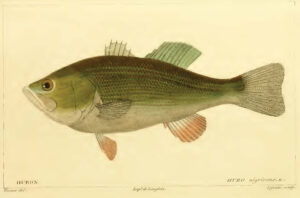
Color plate accompanying Cuvier’s description of Huro (now Micropterus) nigricans. Unfortunately, it’s a poor rendering that scarcely resembles a Largemouth Bass.
26 October
Micropterus nigricans (Cuvier 1828)
Black basses (genus Micropterus, family Centrarchidae) are the most popular recreational gamefishes in North America (and introduced for this purpose around the world). But I’ve always wondered about the common name “black bass.” Why are they called “black” when their predominant color is dark olive or bronze? Yes, they may have dark or black markings on their bodies, but they do not seem black enough to justify the adjective.
Thanks to a recent revision of Micropterus (more on that below), I believe I found the answer in the original description of a newly reinstated species: Micropterus nigricans, proposed (as Huro nigricans) by the famous French anatomist Georges Cuvier in 1828.
The Latin adjective “nigricans” means swarthy or blackish. But Cuvier did not describe a swarthy or blackish fish. He wrote (translated from the French):
The color of this fish, which we have only seen dried, seems to approach that of the carp. Its back is a greenish-brown, fading at the sides, and passing under the belly to a silvery-yellowish-white. A grayish line follows the middle of each longitudinal row of scales.
So why the “blackish” name?
Cuvier described the fish from a specimen from Lake Huron, one of the five Great Lakes of North America, shared on the north and east by the Canadian province of Ontario and on the south and west by the U.S. state of Michigan. According to Cuvier (again translated from the French):
The English [speakers] of the vicinity of this lake call it black-bass or black perch, because it indeed resembles rather in habit [i.e., shape] and tints another fish that bears the same name in the United States, and which we will describe further in our centroprist genus to which it belongs.
The “centroprist” species is the Black Sea Bass, Centropristis striata (Serranidae), which is indeed black.
Cuvier ended his description with an etymological sign-off: “We will give this species the epithet it bears in its native country, Huro nigricans” (Huro referring to Lake Huron).
I now have the answer I sought: Black basses are called black basses because people in early 19th-century America thought Micropterus nigricans looked like a sea bass that occurs in the western Atlantic Ocean over 1100 km away.
I should note for the sake of completeness that Dwight A. Webster, a fisheries professor at Cornell University, proposed a different explanation 42 years ago. Writing in the March-April 1980 issue of Fisheries magazine, Webster suggested that the name “black bass” refers to the resemblance of the Largemouth Bass to a different Atlantic species, the Tautog Tautoga onitis (Labridae), also known as “blackfish.” While the two fishes do share a superficial resemblance, and it’s feasible that early Americans conflated all three species (bass, sea bass, tautog) under one vernacular, Cuvier’s explanation, explicitly linking Micropterus nigricans to Centropristis striata, is impossible to dismiss.
As mentioned above, Micropterus nigricans is a newly reinstated species. According to a recent genomic analysis by Kim et al. (2022), the scientific names M. salmoides and M. floridanus have been incorrectly applied to Largemouth Bass and Florida Bass, respectively, over the past 75 years. Based on their analysis, Kim et al. reveal that M. salmoides is the accurate and valid scientific name for the Florida Bass, whereas M. floridanus, traditionally applied to that species, is a junior synonym of M. salmoides. The oldest available scientific name for the Largemouth Bass is therefore M. nigricans, hence the elevation of that long-forgotten name.
M. nigricans is not the first species of the genus whose scientific name reflects a local name that compares the fish to an unrelated species. In 1802, Lacepède named M. salmoides, meaning “salmon-like,” based on an illustration of a specimen collected near Charleston, South Carolina. Lacepède selected the epithet because the specimen was labeled “trout,” its local name in Charleston.
19 October
From α to ω in the names of fishes (part 3)
Concluding our “miniseries” on fish names inspired by letters of the Greek alphabet …
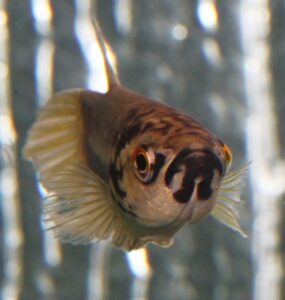
Betta pi (from seriouslyfish.com).
Pi Π π
Perhaps the most famous letter of the Greek alphabet is the 16th, pi. Most of us know it as the ratio of a circle’s circumference to its diameter, approximately equal to 3.14159. But the distinctive shape of the letter has inspired two fish names.
In 1978, Richard P. Vari of the National Museum of Natural History in Washington, D.C., described Protocheirodon pi, a characid from the Amazon basin on Bolivia, Peru and Columbia. He named it for the π-like shape of its swim bladder.
Twenty years later, Heok Hui Tan (National University of Singapore) described the osphronemid Betta pi from the Narathiwat Province of Thailand. He named it for the π-like marking on its throat.
Rho Ρ ρ
I am bending the rules with this one. Chaenopsis resh Robins & Randall 1965, a pikeblenny (Chaenopsidae) from the southern Caribbean Sea, is not named for the Greek letter rho. It’s named for the Hebrew letter resh ( ר), the form of which characterizes this species’ diagnostic postocular mark. I include it because the Phoenician letter Rēsh gave rise to both the Greek and Hebrew forms of the letter.
Sigma Σ σ (or ς when used at the end of a letter-case word)
The Latin letter “S” is derived from the Greek letter Σ. That explains the S-shaped reference in these two names:
Sigmistes Rutter 1898 — This genus of Pacific Ocean sculpins (Psychrolutidae) is named for the strongly arched lateral line of S. caulias, creating an S-like shape. The second half of the name, –istes, is a Latin suffix that serves as a signifying agent, i.e., “one that is shaped like an S.”
Lycodes sigmatoides Lindberg & Krasyukova 1975 — This eelpout (Zoarcidae) from the Sea of Japan and Sea of Okhotsk is named for the S-shaped spots on back. The second half of the name, –oides, is an adjectival suffix meaning “having the form of.” In other words, “S-shaped.”

Lycodes sigmatoides, incorrectly captioned as Lycodes sigmatus. From: Lindberg, G. U. and Z. V. Krasyukova. 1975. Fishes of the Sea of Japan and adjacent territories of the Okhotsk and Yellow Sea. Part 4. Teleostomi. XXIX. Perciformes. 2. Blennioidei – 13. Gobioidei. (CXLV. Fam. Anarhichadidae–CLXXV. Fam. Periophthalmidae). Izdateljestvo Nauka, Leningradskoie Otdeleie, Leningrad. 1-463.
Just as the letter π serves as a mathematical symbol, so does Σ. In modern mathematics Σ means “sum total.” Encrasicholina sigma Hata & Motomura 2020, an anchovy (Engraulidae) from Indonesia, is named for the symbol Σ in reference to the sum total of its gill raker numbers (upper and lower series, 37–42) on the first gill arch, the “major diagnostic feature” of this species.
Tau Τ τ
The Oyster Toadfish Opsanus tau (Linnaeus 1766), a common nearshore fish from Maine to Florida, is named for how the bones on its head, when dried, show a T-shaped figure.
Upsilon (or Ypsilon) ϒ υ
The 20th letter of the Greek alphabet is transliterated in the traditional Latin style as “y” or in the modern style as “u.” As such, the name of the letter is spelled two ways: upsilon and ypsilon. Fishes have been named both ways. For example:
Gymnothorax ypsilon Hatooka & Randall 1992, a moray eel (Muraenidae) from Japan, Hawaii and New Zealand, is named for how the bars on its body branch dorsally to form a Y-shape. Compare this with …
Oman ypsilon Springer 1985 — This blenny from the Persian Gulf is named for the dark U-shaped marking on the anterodorsal surface of its head.
Several other fish names (six by my count) are named for Y-shaped bars, lines, head ridges, photophores, and other externally visible features. This one is named for an internal feature that cannot be seen by the naked eye:
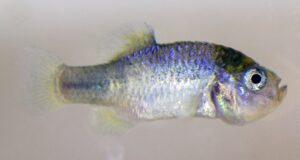
The last captive-bred male Megupsilon aporus photographed in the laboratory of Christopher Martin at UC Berkeley.
Megupsilon Miller & Walters 1972 is a monotypic genus of pupfshes (Cyprinodontidae) known only from a spring in Nuevo Léon, Mexico. Its name is a combination of mega, meaning large, and upsilon, referring to the exceptionally large Y chromosome in males. The sole species, Megupsilon aporus, went extinct in the wild in 1994. The last surviving specimen in captivity died in 2014.
Phi Φ φ
As far as I can tell, no fishes are named for the Greek letter phi (pronounced “p” as in “pot”).
Chi Χ χ
This, the 22nd Greek letter, is not to be confused with the 14th letter, Xi Ξ ξ. The confusion lies in the fact that Xi is pronounced “ks” as in “fox,” whereas Chi (pronounced “k” as in “cat”) looks like the letter “x.” (See previous post about Cynodonichthys xi.) Be that as it may, the authors of Xenisthmus chi Gill & Hoese 2004 got it right: This collared wiggler (Xenisthmidae) from the Timor Sea of Western Australia is named for the X-shaped markings on its body.
Psi Ψ ψ
As far as I can tell, no fishes are named for the Greek letter psi (pronounced “ps” as in “lapse”).
Omega Ω ω
The distinctive Ω shape of omega is likely conveyed in the name of the puffer genus Omegophora (“omega bearer”), coined by Gilbert Percy Whitley in 1934. Whitley didn’t explain the name but it almost certainly refers to the narrow, black, Ω-shaped ring around the pectoral-fin base of its type species, O. armilla.
The fact that omega is the last letter of the Greek alphabet is reflected in these two names:
Aphyosemion omega (Sonnenberg 2007) — This non-annual killifish from Cameroon is in the same subgenus (Chromaphyosemion) as A. alpha (mentioned in part one of this series). Sonnenberg chose the name with regard to A. alpha in the sense of alpha (the beginning) and omega (the end), referring to the relative (phylogenetic) position of both species, with C. alpha as the basal species and C. omega as a more derived species, the result of a recent radiation.
Just as in Betta pi (mentioned above), Betta omega Tan & Ahmad 2018, from peninsular Malaysia, is named for the letter-like marking on its throat, in this case resembling Ω instead of π. The name has a sadder meaning as well. The “last members” of this species, the authors wrote, are quickly disappearing in the wild.
12 October
From α to ω in the names of fishes (part 2)
Continuing our survey of fish names inspired by letters of the Greek alphabet …
Zeta Ζ ζ
Although zeta is the sixth letter of the Greek alphabet, it is the 26th and final letter of the modern English alphabet. For this reason the letter Z is often associated with things that are last or final. As in this fish’s name:
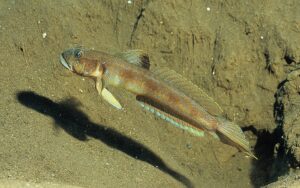
Oxyurichthys zeta, live specimen at Lovina Beach, Bali, Indonesia. Photograph by Ole Brett. From: Pezold, F. L. and H. K. Larson. 2015. A revision of the fish genus Oxyurichthys (Gobioidei: Gobiidae) with descriptions of four new species. Zootaxa 3988 (no. 1): 1-95.
Oxyurichthys zeta Pezold & Larson 2015 is a goby that hovers over the substrate in marine waters (12-38 m deep) off Japan, Palau, Bali, Flores, Papua New Guinea and Solomon Islands. The authors named it zeta because it’s the last of 20 species included in their revision of Oxyurichthys — although, they write, “it is unlikely to be the last species described for this genus.” (Indeed, one additional species has been described so far.)
Astronesthes zetgibbsi Parin & Borodulina 1997 is a snaggletooth (Stomiidae) known from 80 meters deep in the southeastern Pacific. The “zet” part of the name refers to the letter Z. The second part of the name honors Robert H. Gibbs, Jr. (1929-1988), “one of the most authoritative researchers” (translation) of the family and other stomiiform fishes. Gibbs called this taxon “species Z” in his unpublished materials.
Eta Η η
As far as I can tell, no currently valid fish taxa are named for Greek letter #7, eta.
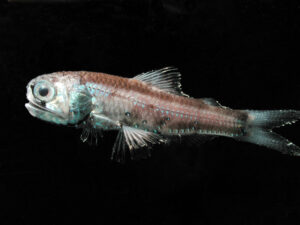
Diaphus zeta with photophores. Photo courtesy of Jeff Drazen. From: Exploring Our Fluid Earth
Theta Θ θ
Diaphus theta Eigenmann & Eigenmann 1890 is the type species of the speciose (81 species) lanternfish genus Diaphus. Lanternfishes, as the common name suggests, are bioluminescent. Both generic and trivial names of D. theta refer to how most or all of its photophores are divided by a horizontal cross septum of black pigment: dia– means divided and phos means light, resembling the divided “0” shape of the Greek letter θ, theta.
Iota Ι ι
Iota is the smallest letter of the Greek alphabet. Because of this, iota is also a noun that means “an extremely small amount.” Ichthyologists have used “iota” several times for fishes that are small. Here are two examples:
Iotichthys Jordan & Evermann 1896 — a monotypic minnow genus endemic to Utah (USA). Iotichthys phlegethontis, the Least Chub, reaches a maximum size of less than 6.4 cm. (I assume you know what ichthys means.)
Eviota Jenkins 1903 — a diverse (128 species and counting) genus of gobies. The Greek prefix eu– (Latinized to ev– for euphony) means good, well or very, i.e., very small. Jenkins coined the name for E. epiphanes, which, at 1.0-1.9 cm in length, he believed was the “smallest vertebrate that has up to this time been described.”
The Guyanese tetra Hemigrammus iota Durbin 1909 may be small but that’s not why it was given its name. Iota is the precursor to both “I” and “J” in the Latin alphabet. Marion Durbin (1887-1972, also known by her married name, Marion Ellis) named it for the black I-shaped bar on its caudal peduncle.
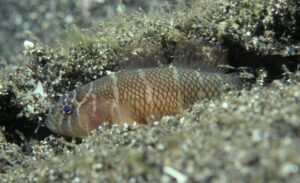
Priolepis kappa, live specimen at Bali, Indonesia. Photo by John E. Randall. Courtesy: FishBase.
Kappa Κ κ
Priolepis kappa Winterbottom & Burridge 1993 is a goby found in the Indo-West Pacific from the Comoro Islands to Indonesia, Philippines and to Queensland, Australia. It’s named for the Greek letter kappa, referring to the stylized “k” formed by its postocular and ocular bars.
Lambda Λ λ
Leptojulis lambdastigma Randall & Ferraris 1981 is a wrasse (Labridae) from the eastern Indian and western Pacific oceans from the Andaman Islands, east to Philippines and north to Taiwan. It’s named for the conspicuous Λ-shaped mark (stigma) on its nape.
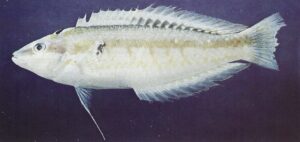
Leptojulis lambdastigma, holotype, male. Photo by Carl Ferraris. From: Randall, J. E. and C. J. Ferraris, Jr. 1981. A revision of the Indo-Pacific labrid fish genus Leptojulis with descriptions of two new species. Revue française d’Aquariologie Herpétologie v. 8 (no. 3): 89-96.
I do not see any fishes named for the next two letters of the Greek alphabet … Mu Μ μ
Nu Ν ν.
Xi Ξ ξ
Cynodonichthys xi (Vermeulen 2013) — This rivulid killifish from Colombia is named for the 14th letter of the Greek alphabet, referring to the unique x-markings on the sides of males. “Xi” is easily confused with the 22nd letter of the Greek alphabet, “chi” (pronounced “k” as in cat), because “chi” is written as “x” in Latin. So maybe Cynodonichthys xi should have been named Cynodonichthys chi?
Omicron Ο ο
I do not see any fishes named for omicron, but I’m sure you recognize the letter as the name of a highly contagious and now predominant variant of the SARS-CoV-2 virus. The World Health Organization assigns a Greek letter to each variant in the order in which they appear. Omicron was the 13th variant but WHO skipped over the 13th (Nu) and 14th (Xi) letters to avoid confusion with the English word “new” and the common Chinese last name “Xi.”
Next week we’ll conclude this series beginning with the ever-popular π.
5 October
From α to ω in the names of fishes (part 1)
Taxonomists draw inspiration from many sources in the zoological names they coin. Here are some of the fish names inspired by letters of the Greek alphabet.
Alpha Α α
Aphyosemion alpha Huber 1998 is a non-annual killifish from Gabon. It’s named for the red α-shaped dots on the sides of males.
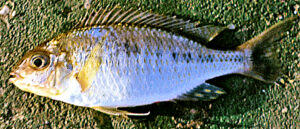
Otopharynx alpha, photograph by George Turner, courtesy Michael Oliver.
Otopharynx alpha Oliver 2018 is a cichlid from Lake Malaŵi, Africa. Its name refers to its suprapectoral spot and posterior stripe, which suggest a dot and dash (*-), an “A” in International Morse Code.
Chromis alpha Randall 1988 is an Indo-Pacific damselfish that occurs from Christmas Island to the Society Islands, north to the Mariana Islands, and south to New Caledonia through Micronesia. Its name has a double meaning. It alludes to the Greek alphós (ἀλφός), meaning white-spotted (as from leprosy), referring to the pale spots on its head and body. The name also refers to the first letter of alphabet, referring to its designation as Chromis sp. “A” by Gerald R. Allen, who first diagnosed and illustrated this species in 1975
Beta Β β
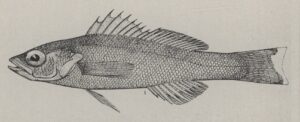
Schultzea beta. From: Longley, W. H. and S. F. Hildebrand. 1940. New genera and species of fishes from Tortugas, Florida. Papers Tortugas Laboratory, Carnegie Institution of Washington v. 32: 223-285, Pl. 1.
Schultzea beta (Hildebrand 1940) is a small, schooling sea bass (Serranidae) from deeper waters around coral reefs in the Caribbean Sea and off the Florida Keys. It’s named for the second letter of the alphabet because it’s the second species from Tortugas (Florida, USA) of “uncertain generic affinities” included in Hildebrand’s paper (co-authored with William H. Longley).
Opsanus beta (Goode & Bean 1880) is an oyster toadfish that occurs in the Gulf of Mexico and western Atlantic off Florida and the Bahamas. Albert Günther described it as a southern form of Opsanus tau (itself named after a Greek letter; more in a future installment) in 1861, using the Greek “α” for the northern form and the Greek “β” for this one. When Goode & Bean decided that the form warranted its own name, they spelled out Günther’s “β.”
Gamma Γ γ
Knodus gamma Géry 1972 — French ichthyologist Jacques Géry did not explain why he selected this name for a characin from the western Amazon basin of Colombia, Ecuador, Peru and Bolivia. But the context is clear. Géry was continuing Carl Eigenmann’s tradition of naming closely related and similar taxa after Greek letters (e.g., Bryconamericus alpha and B. beta). So Géry named the third such species after the third letter of the Greek alphabet, and the fourth species, K. delta, after the fourth. Speaking of delta …
Delta Δ δ
The triangular shape of the upper-case delta (Δ) has inspired several names.
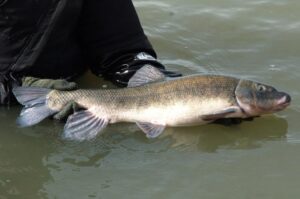
Deltistes luxatus, courtesy The Oregon Conservation Strategy.
Gill (1863) named the goby genus Deltentosteus (osteus = bone) for the Δ-like shape of the lower pharyngeal bones of D. quadrimaculatus.
Alvin Seale proposed Deltistes as a monotypic genus for the federally endangered Lost River Sucker D. luxatus of northern California and Orgeon (USA). He named it for its Δ-shaped gill rakers.
The husband-and-wife team of Eigenmann & Eigenmann (1889) named the catfish (Loricariidae) genus Delturus for the tail (urus) of Delturus parahybae, described as flat above, trenchant below, and Δ-shaped in cross section.
Chaenopsis deltarrhis Böhlke 1957, a pikeblenny (Chaenopsidae) from the eastern Pacific of Costa Rica south to Colombia, is named for the triangular shape of its snout (rhis) when viewed from above
The near-triangular shape of its vomerine tooth patch inspired the name of Ostichthys delta Randall, Shimizu & Yamakawa 1982, a squirrelfish from the Indo-West Pacific of Réunion (western Mascarenes), Comoros and Samoa.
The name of Pycnochromis delta (Randall 1988), a wide-ranging damselfish from the eastern Indian Ocean and western Pacific, harkens back to Chromis sp. “A” mentioned above. Gerald R. Allen called this one Chromis sp. “D.”
Epsilon Ε ε
As far as I can tell, no currently valid fish taxa are named for Greek letter #5, epsilon. Bummer.
Next week we’ll explore zeta, theta, iota in part 2 of our piscine alphabetarium.
28 September
Gerald R. Smith (1935-2022)
Soon after I posted last week’s tribute to the late Victor G. Springer, I learned that another ichthyological luminary had passed. Gerald R. Smith, Emeritus Curator of Fishes for the Museum of Zoology and Emeritus Curator of Lower Vertebrates for the Museum of Paleontology at the University of Michigan, died peacefully at home, surrounded by family, at the age of 87.
Dr. Smith — Jerry to family, friends and colleagues — was born March 20, 1935 in Los Angeles, California, and was raised in Salt Lake City, Utah, where he earned a B.S. (1957) and M.S. (1959) at the University of Utah. In 1965, he completed his Ph.D. in Zoology at the University of Michigan, studying under the legendary Robert Rush Miller (see 22 April 2015 NOTW).
Dr. Smith’s primary field of study was the evolution of North American freshwater fishes, with particular interests in Cenozoic fossils, the calibration of rates of evolution, speciation, biogeography, and conservation. His primary field work was in the Great Basin and on the Snake River Plain. In western Idaho and eastern Oregon, living fishes in the Snake River are surrounded by sediments bearing the fossils of their ancestors’ sedimentary sequences from 2-10 million years old, providing a rich laboratory for the study of evolution. Dr. Smith was also an authority in the identification and ecology of fishes of the Laurentian Great Lakes. He published a revised edition of Hubbs & Lagler’s classic Fishes of the Great Lakes Region in 2004.
While not primarily a taxonomist, Dr. Smith did describe or co-describe four fish taxa, all suckers (Catostomidae) of the American West:
Catostomus columbianus hubbsi Smith 1966, a subspecies of Bridgelip Sucker from the Wood River drainage of Blaine County, Idaho — in honor of Carl L. Hubbs (1894-1979), for his work on western American fishes, his leadership in ichthyology, and for collecting the holotype.
Chasmistes liorus mictus Miller & Smith 1981, the June Sucker, endemic to Utah Lake, Wasatch County, Utah — name derived from the Greek miktos, mixed or blended, believed to be a hybrid between C. liorus and Catostomus ardens (a hypothesis since challenged by another researcher).
Chasmistes muriei Miller & Smith 1981, the extinct Snake River Sucker of Wyoming — in honor of wildlife biologist Olaus J. Murie (1889-1963), who collected the only known specimen in 1927.
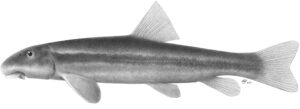
Paratype of Pantosteus bondi, 118 SL, from the South Santiam River at Lebanon, Willamette drainage, Linn Co., Oregon. Illustrated by John Megahan. From: Smith, G. R., J. D. Stewart and N. E. Carpenter. 2013. Fossil and recent mountain suckers, Pantosteus, and significance of introgression in catostomin fishes of the western United States. Occasional Papers of the Museum of Zoology University of Michigan No. 743: 1-59.
Pantosteus bondi (Smith, Stewart & Carpenter 2013), the Cordilleran Sucker of the Columbia and Lower Snake River drainages of Oregon — in honor of the late Carl E. Bond (1920-2007), Oregon State University, for his many contributions to the science, conservation, and management of northwestern North American fishes.
Dr. Smith described or co-described several fossil suckers as well.
On a personal note, news of Dr. Smith’s death was especially sad for me since my wife and I had spent a weekend with him during the annual convention of the North American Native Fishes Association (NANFA) in Ann Arbor, Michigan, in 2002. Dr. Smith was complimentary of my work as editor of American Currents, NANFA’s quarterly publication. In fact, he had a copy on display in the rotunda of the University of Michigan Museum of Zoology (UMMZ).
Dr. Smith invited us to poke around the UMMZ fish collection, the fourth largest (among eight) International Ichthyological Resource Center in North America. It was a treat for me to see the very same specimens that Carl Hubbs and Robert Rush Miller collected during their famous expeditions to the American West (see 22 April 2015 NOTW). I got to hold in my hands the all-but-forgotten Las Vegas dace (Rhinichthys deaconi, see 4 March 2015 NOTW), knowing that this fish went extinct for the benefit of Las Vegas fountains and golf courses. Many specimen jars were adorned with the red “extinct” label and I examined them all, wondering how many others would soon be joining their ranks.
After touring the stacks, Dr. Smith put us to work. The University had developed a beta version of an on-line database of Great Lakes flora and fauna and wanted us to test the fish portion of it while the site’s designers looked on. We were more than happy to comply, especially since Dr. Smith treated us to beer, pop and assorted snack goodies.
 Later that same weekend, while snorkeling and collecting fishes in a Michigan stream, my wife and I got separated from our party. Dr. Smith graciously drove us back to our hotel in his pick-up truck, going miles out of his way. He talked with obvious joy about his farm and his passion for sustainable agriculture. Earlier in the day I snapped the photo shown here: Dr. Smith explaining the subtle differences between Blacknose (Notropis heterolepis) and Blackchin Shiner (N. heterodon) to a seemingly astonished Nick Zarlinga of the Cleveland Metroparks Zoo.
Later that same weekend, while snorkeling and collecting fishes in a Michigan stream, my wife and I got separated from our party. Dr. Smith graciously drove us back to our hotel in his pick-up truck, going miles out of his way. He talked with obvious joy about his farm and his passion for sustainable agriculture. Earlier in the day I snapped the photo shown here: Dr. Smith explaining the subtle differences between Blacknose (Notropis heterolepis) and Blackchin Shiner (N. heterodon) to a seemingly astonished Nick Zarlinga of the Cleveland Metroparks Zoo.
Tributes from others say much the same thing. Gerald R. Smith was a superb scientist, an excellent teacher always willing to share his knowledge, a steward of the Earth, and a soft-spoken, kind and generous human being.
 21 September
21 September
Victor G. Springer (1928-2022)
Victor G. Springer, Curator Emeritus of Fishes at the Smithsonian Institution’s National Museum of Natural History, passed away peacefully on Sunday, September 18, at the age of 94. When I heard this news, I dropped the NOTW I had been writing and prepared this one instead. It took me close to an hour to comb through ETYFish looking for all the fishes that Springer named and for all the fishes named after him. By my unofficial count:
Springer described or co-described 20 new fish genera considered valid today.
Springer described or co-described 113 new species of fishes considered valid today.
Many of these new taxa are blennies (especially those of the genus Ecsenius) and other blenniiform fishes. But Springer also made valuable contributions to the taxonomy of sharks, gobies, clingfishes (Gobiesocidae), and dottybacks (Pseudochromidae), to name just a few. A long and impressive career.
Even more impressive is the number of taxa named after him. I count 20 currently valid fishes named “springeri” and one named “gruschkai” (after his middle name), ranging from gudgeons (Gobionidae) to flathead (Platycephalidae), with lots of blennies in between. Here is one example:
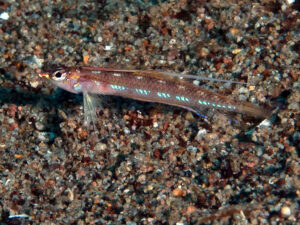
Pteropsaron springeri, photographed at Dauin, Philippines. Photo by Andrey Ryanskly. Courtesy: FishBase.
Pteropsaron springeri Smith & Johnson 2007, an Indo-Pacific duckbill (Hemerocoetidae) from Negros Island of the Philippines (shown here) — in honor of colleague Victor G. Springer, who first collected this species and recognized it as undescribed, for his “many contributions to our knowledge of Indo-Pacific reef fishes, and his unselfish and steadfast dedication to the growth and well being of the collections and the advancement of ichthyology at the National Museum of Natural History”
Having a species named after you is, of course, a wonderful honor. Having an entire genus named after you is a supreme honor indeed. Springer has two, from the same ichthyologist: Springeratus Shen 1971 (kelp blennies, Clinidae) and Springerichthys Shen 1994 (threefin blennies, Tripterygiidae). Shen clearly admired his colleague.
There’s nothing I can say about Dr. Springer’s storied career that wasn’t already said in this superb retrospective:
Smith, David G. 2005. “Historical Perspectives – Victor Gruschka Springer.” Copeia 2005 (3): 431–439.
It’s behind a paywall but you can read a summary here.
As mentioned in the Copeia article, Dr. Springer not only collected fishes. He collected postage stamps too, specifically those with images of fish or fishing. In 1985, he co-authored a booklet that contained an annotated list of all such stamps that were issued from 1865 through 1992, with all of the species correctly identified. He and his philatelic colleague, the late Maynard S. Raasch (author of a delightful little book on the fishes of Delaware, USA), continued adding to the list through 1998. By the time they finished, the list contained about 10,000 entries.
Collecting, cataloguing, classifying, organizing — these are the joys of a taxonomist’s life. For Victor G. Springer, it must have been a joyful life indeed.
14 September
Bach, Beethoven, Mozart, and the piquitinga herring of Brazil
The name piquitinga — as in Lile piquitinga (Schreiner & Miranda Ribeiro 1903), a gizzard shad from the Atlantic drainages of Costa Rica, Venezuela and Brazil — is not crucial to this story. But it’s too good a story not to tell. Whether it’s searching for the meaning of a name, or in this case a 17th-century painting of a fish, we can relate to the dogged pursuit of historical minutiae this story exemplifies, and the larger discoveries that can happen as a result.
Historia Naturalis Brasiliae, published in 1648, is the first scientific work on the natural history of Brazil. Among the fishes discussed and illustrated is one that author Georg Marcgrave (to use one of the most common spellings of his last name) called “Piquitinga,” presumably its indigenous name. Early taxonomists such as Linnaeus and Cuvier determined that Marcgrave’s description and accompanying woodcut illustration represent a species of anchovy. Over 250 years later, Schreiner & Miranda Ribeiro incorporated Marcgrave’s account into their description of Sardinella piquitinga (now known as Lile piquitinga), a species of herring now in the gizzard shad family (Dorosomatidae).
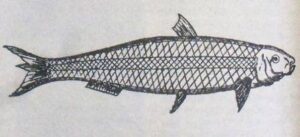
The woodcut illustration of piquitinga from Historia Naturalis Brasiliae (1648), lacking diagnostic detail.
Peter J. P. Whitehead (1930–1993) of the British Museum (Natural History), an expert in clupeoid fishes (herrings, anchovies and the like), was not convinced that Marcgrave’s piquitinga had been accurately identified. Marcgrave’s written description was general and vague, and the woodcut illustration (shown here) omitted or distorted important diagnostic features. Whitehead simply wanted to know: Was piquitinga a herring or an anchovy?
Whitehead knew that the woodcuts in Historia Naturalis Brasiliae were based on paintings and, as such, likely contained more accurate and realistic details that might make a positive ID possible. Macrgrave’s original paintings had been deposited at Preussische Staatsbibliothek, the Prussian State Library in Berlin. Librarians told Whitehead that the paintings had been lost during World War II.
It was 1973. The Soviet Union controlled eastern Europe. The libraries and archives Whitehead wanted to visit were on the eastern side of the Berlin wall. Access was difficult if not impossible. Undaunted, Whitehead pushed on. The search, as he described it, “took on something of an obsession.”
Whitehead soon learned that Marcgrave’s paintings had been evacuated to Silesia (a historical region of Central Europe that lies mostly within Poland) to protect them from Allied bombs. Rumors swirled that the paintings had been destroyed in a fire. A year later Whitehead received word from a Benedictine monk at a small monastery in Grüssau (now Krzeszów), Poland, where the paintings had been hidden. They had not been burned in a fire, the monk said, but that they had been removed by Army trucks in 1946, their whereabouts unknown.
“I was now more determined than ever to track them down,” Whitehead later wrote.
At this point, Whitehead discovered that the collection at Grüssau also contained some of the Berlin library’s musical treasures — the original manuscript scores to Mozart’s “Magic Flute” opera and “Jupiter” symphony, Beethoven’s 7th, 8th and 9th symphonies, Mendelssohn’s violin concerto and “Midsummer Night’s Dream” overture, numerous Bach cantatas, and hundreds of other scores. Like Marcgrave’s paintings, they were taken to Grüssau in 1941, presumably in the same wooden crate, to escape the ravages of the war and had not been seen since.
Whitehead called this development a “considerable stroke of luck” because, he said, it was easier to interest people in looking for lost musical treasures than for an obscure painting of an obscure Brazilian fish.
Whitehead enlisted the help of UNESCO and the British Embassy in Warsaw. He asked the Polish Ministry of Culture to investigate and they did, claiming to have searched every Polish library but finding nothing. And, whenever he could, Whitehead called on musicologists and classical music fans to send him leads, news of rumors, clues, any scrap of information that might prove useful. Someone suggested that he contact Prof. Jan Bialostowki, “Poland’s premier art historian.” Whitehead sent him a form letter asking for his help. Some months later, in March 1977, he received a reply.
The “problem of the lost manuscripts has been cleared up,” Bialostowki calmly announced. They were found at the Jagiellonian Library in Krakow.
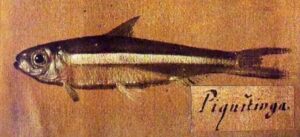
The long-lost oil painting upon which the woodcut was based.
Over two years later, in September 1979, Whitehead visited the Jagiellonian Library. A librarian wheeled in a trolley bearing seven large volumes. Lifting one of the volumes, the librarian opened it at a marked page: “There!” he said. “There is your piquitinga!”
The painting (shown here) erased all doubts. It was indeed the small herring Lile piquitinga.
Etymological footnote: The genus name Lile is a bit odd in that it’s an Indian (India) name for fishes from North and South America. The name was proposed by Jordan & Evermann in 1896 as a subgenus of Sardinella. Jordan & Evermann said the name derived from matt-lile, a local Tamil language name for Clupea lile (originally Meletta lile Valenciennes 1847) from Pondicherry (now Puducherry), India. Even though two oceans and continents separated the two fishes, Jordan & Evermann believed that Clupea lile (now a junior synonym of Escualosa thoracata Valenciennes 1847) and Sardinella stolifera, the Striped Herring from Mazatlan, Mexico, were closely related and belonged in the same subgenus. They selected the older name Lile to convey this relationship, but they designated the newer species, S. stolifera, as the representative type of the new subgenus (now a full genus). When future taxonomists realized Clupea lile and Escualosa thoracata were the same species, they removed the Indian species that inspired the Lile name, leaving four species that occur nowhere near India — the eastern Pacific Lile stolifera, L. gracilis and L. nigrofasciata, and the southwestern Atlantic L. piquitinga — with an Indian name.
7 September
Dirty, filthy names
You may want to wash your hands after perusing these names.
Callogobius illotus (Herre 1927) — The specific epithet of this marine goby (Gobiidae) from the Philippines is Latin for “unwashed” or “dirty.” It refers to the dark or blackish papillae on the goby’s head, which Herre described as “giving the appearance of adhering dirt or trash.”
Astrapogon alutus (Jordan & Gilbert 1882) — Alutus appears to be a Latinization of the Greek áloutos (ἄλουτος), also meaning “unwashed” or “dirty.” Jordan & Gilbert used it to describe this cardinalfish (Apogonidae) from the northern Gulf of Mexico and Caribbean. Its body and fins, the authors said, are “everywhere much soiled and freckled with dark points.”
Citharichthys sordidus (Girard 1854) — The Pacific Sandab (Cyclopsettidae) is a flatfish from the northern Pacific Ocean from the Sea of Japan to the California coast. Today we use the adjective “sordid” to describe ignoble actions and motives that arouse moral distaste and contempt. Its Latin precursor, sordidus, means dirty, filthy or nasty. Girard did not explain why he selected this adjective, but it probably refers to the fish’s fins, which, to quote Girard, “appear as if covered with a coating of dust.”
Trichomycterus illuvies Reis & de Pinna 2022 The name of this recently described catfish (Trichomycteridae) is the noun form of the Latin adjective illotus mentioned above. It means filth and dirt (with an additional definition, an overflowing or flood). The name refers not to the fish, but to the “environmental mayhem” caused by the mining company Samarco SA on the Rio Doce of Minas Gerais, Brazil, where it occurs. The authors say the name is a “long-term reminder of the catastrophe suffered by that hydrographic basin.”

Austrobatrachus foedus. Illustration by Denys M. Davis. From: Smith, J. L. B. 1949. The sea fishes of southern Africa. Central News Agency, Ltd., Cape Town. I-xii + 1-550, Pls. 1-103.
Austrobatrachus foedus (Smith 1947) — J. L. B. Smith, one of the great masters of the enigmatic name, enigmatically assigned the Latin adjective foedus to this toadfish found off the coast of South Africa. Foedus means fetid, foul, filthy or detestable, but Smith did not explain what he found so loathsome about this fish. He said it occurs in “deepish water, thrown up after storms,” so maybe his specimens were “thrown up” and in a fetid condition? His illustration of the fish, as it appeared in the first edition of his classic Sea Fishes of Southern Africa (1949) is shown here. Judge for yourself.
 31 August
31 August
Andinoacara stalsbergi Musilová, Schindler & Staeck 2009
Two weeks after we reported the passing of James Langhammer, we learned that another pioneering member of the aquarium hobby has passed — although the news was slow to reach us. Alf Stalsberg, of Larvik, Norway, died on 4 March 2022, a month shy of his 74th birthday.
Alf specialized in South American cichlids. He frequently left his fish room to collect in the field, sometimes covering specific area at the request of ichthyologist friends. He spoke at aquarium clubs around the world, penned many articles, and generously shared his knowledge. Check out his website.

Topotypic female of Andinoacara stalsbergi showing breeding color pattern in the aquarium. Photo by Alf Stalsberg. From: Musilová, Z., I. Schindler and W. Staeck. 2009. Description of Andinoacara stalsbergi sp. n. (Teleostei: Cichlidae: Cichlasomatini) from Pacific coastal rivers in Peru, and annotations on the phylogeny of the genus. Vertebrate Zoology v. 59 (no. 2): 131-141.
In 2008, Alf collected a cichlid from the Río Pisco in southern Peru. It turned out to be a new species. The authors named it in Alf’s honor, “in recognition of his longstanding commitment to increase the knowledge about cichlid fishes.”
The etymology of the generic name Andinoacara, proposed by Musilová, Říčan and Novák, also in 2009, is comprised of two parts. Andino– refers to the Andes mountain chain, where the genus is distributed on both cis- and trans-andean slopes and in the intervening valleys of the Northern Andes. Acará is the Tupí-Guaraní word for cichlids.
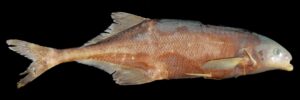
Holotype of Marcusenius gracilis (now known as Marcusenius elegans), male, 22.1 cm SL. From: Kramer, L. B. 2013. Differentiation in morphology and electrical signalling in four species of para- and sympatric Marcusenius (Teleostei: Mormyridae) from Côte d’Ivoire, West Africa. Marine and Freshwater Behaviour and Physiology v. 46 (no. 2): 105-133.
24 August
Marcusenius gracilis is now Marcusenius elegans
Biological nomenclature requires careful bookkeeping. Just as an accountant may discover errors when auditing a ledger or financial statement, a taxonomist can discover errors when auditing the taxa in a particular group of organisms. That’s what happened when we revised the ETYFish entries for the mormyrids (also known as elephantfishes) of Africa, family Mormyridae. While double-checking the entry for Marcusenius gracilis, described by Bernd Kramer from the Ivory Coast of West Africa in 2013, we noticed that another mormyrid had the same name
In 1922, Jacques Pellegrin described Gnathonemus gracilis based on a specimen from the Gribingui River, Lake Chad basin, in today’s Central African Republic. The species was later treated as a valid subspecies of the West African Marcusenius senegalensis (Steindachner 1870). This means that Marcusenius gracilis Kramer 2013 is a secondary junior homonym of Marcusenius senegalensis gracilis (Pellegrin 1922).
Since no two taxa in the same genus can have the same specific epithet, a replacement name is needed.
We sent notice of this discrepancy to Ronald Fricke, one of the editors of Eschmeyer’s Catalog of Fishes. He contacted Bernd Kramer and they collaborated on a replacement name, recently published in the journal Zootaxa.
Marcusenius gracilis — originally named for its slenderer body (gracilis is Latin for thin or slender) compared with other Ivorian and many other West African Marcusenius species — is now named Marcusenius elegans. The epithet elegans (Latin for elegant) also refers to its slender body.
In case you’re wondering, the generic epithet Marcusenius, proposed by American ichthyologist Theodore Gill in 1862, is named for Baltic German physician-ichthyologist Johann Marcusen (1817–1894), who wrote the first systematic study of mormyrids in 1854.
This is not the first name change our “careful bookkeeping” has necessitated. In 2017, we presented evidence that Typhliasina pearsei, a blind cusk-eel (family Dinematichthyidae), should actually be called Typhlias pearsei. (See NOTW 13 Sept. 2017.) And in 2020, we discovered that two snake mackerels (family Gempylidae), known as Thyrsites atun and Thyrsitops lepidopoides, should be called Leionura atun and Thyrsites lepidopodea, respectively. (See NOTW 11 March 2020.)
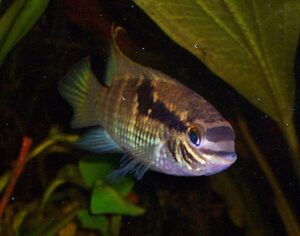
Laetacara flavilabris. © Stephan Schneider. Courtesy: FishBase.
17 August
Laetacara Kullander 1986
This week’s name, for the Neotropical cichlid genus known as Smiling Acaras, is a tribute to aquarist James K. Langhammer, who passed away on 28 July at the age of 86. It was Jim who suggested the name “smiling acara” back in 1971, referring to the smile-like snout markings of Laetacara flavilabris (then known as Aequidens thayeri) and other members of the genus. When ichthyologist Sven Kullander proposed the genus in 1986, he said he was inspired by Jim’s name. Laetus is Latin for happy, glad or joyful. Acará is the Tupí-Guaraní word for cichlids.
While he was a pioneering cichlid aquarist — Jim was a founding member and first president of American Cichlid Association — it’s his work with goodeids for which he is best remembered today.
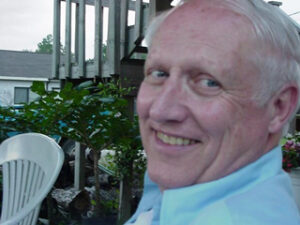 Goodeids (Goodeidae) are a family of killifish-like fishes with a disjunct distribution in the Death Valley system of central Nevada and the Mesa Central of México. The four American species (one is extinct) are egg-layers. The 40 or so species from México are livebearers (viviparous). Unlike traditional livebearers (poeciliids), males of which fertilize females through a modified anal fin called a gonopodium, Mexican goodeids possess an internal, muscular structure called a pseudophallus that connects the sperm ducts to the genital opening. It is through the extrudable pseudophallus that males fertilize females. Females in all species give nutrition to their young through a structure (called a trophotaenia) that’s analogous to the placenta in mammals.
Goodeids (Goodeidae) are a family of killifish-like fishes with a disjunct distribution in the Death Valley system of central Nevada and the Mesa Central of México. The four American species (one is extinct) are egg-layers. The 40 or so species from México are livebearers (viviparous). Unlike traditional livebearers (poeciliids), males of which fertilize females through a modified anal fin called a gonopodium, Mexican goodeids possess an internal, muscular structure called a pseudophallus that connects the sperm ducts to the genital opening. It is through the extrudable pseudophallus that males fertilize females. Females in all species give nutrition to their young through a structure (called a trophotaenia) that’s analogous to the placenta in mammals.
Jim — known as “Hammer” among his friends — began breeding goodeids when he was Curator of the historic Belle Isle Aquarium in Detroit, Michigan, USA. Legendary ichthyologist Robert Rush Miller maintained research stocks of goodeids at the University of Michigan. When the fish labs closed in 1979, they were transferred to Jim’s capable hands. Most of the goodeids currently in the hobby are believed to have come from Jim’s stocks, which he had freely given away to hobbyists, universities, and public aquariums around the world for decades.
In 2010, the American Livebearer Association (ALA) established the James K. Langhammer Fund for Conservation. The purpose of the fund is to financially support the habitat restoration and recovery of imperiled livebearing fishes, research and education related to their conservation, and their breeding and maintenance in captivity.
Rest in pisces, Jim.
 10 August
10 August
The Father of Ichthyology
Swedish naturalist Peter Artedi (1705-1735) has long been considered the “Father of Ichthyology.” His “Ichthyologia sive opera omnia piscibus” (1738) is the first publication to divide fishes into orders, orders into genera, and genera into species, and to use uninominal generic names throughout. It also provided diagnoses of all taxa known at the time and developed standard methods for making counts and measurements of anatomical features. A recent paper in the journal Zootaxa details Artedi’s “immense significance to ichthyology and perhaps of even greater importance to the history of the development of biosystematics in general.” The paper, by ichthyologist Theodore W. Pietsch and classical scholar Hans Aili, is an introduction of sorts to the imminent publication of the first English translation of Artedi’s “Ichthyologia” (also by Pietsch and Aili). “The opportunity to study ‘Ichthyologia’ in English for the first time,” the authors write, “emphasizes like never before Artedi’s thoroughly modern approach.”
Pietsch and Aili’s paper prompted us to review the currently valid fish taxa named after the “Father of Ichthyology.” They are, in chronological order:
Coregonus artedi Lesueur 1818 — the Cisco (Salmonidae) of the Arctic and Atlantic basins of Canada and northern USA. Lesueur did not say for whom he named the species, but it was Artedi who coined the name “Coregonus.”
Artedius Girard 1856 — a genus of sculpins (Cottidae, sometimes placed in Psychrolutidae) with five species that occur in intertidal waters ranging from the Bering Sea to Baja California. Like Lesueur, Girard did not explicitly identify Artedi (Latinized as Artedius) as the dedicatee. But who else could it be?
Hypopomus artedi (Kaup 1856) — a bluntnose knifefish (Hypopomidae) from Brazil, Bolivia, French Guiana, Guyana and Suriname. Like his predecessors, Kaup did not explicitly mention Artedi in his description. Perhaps Artedi was so well known that mentioning him was stating the obvious.
Artedidraco Lönnberg 1905 — a genus of barbled plunderfishes (Artedidraconidae) from the Southern Ocean of Antarctica. Lönnberg, a fellow Swede, named this genus on the 200th anniversary of Artedi’s birth. The second half of the name, draco, is from drakṓn, dragon, an ancient Greek name of the weeverfish genus Trachinus (Percoidei, Trachinidae), but in this case possibly refers to its relationship (as mentioned by Lönnberg) to Draconetta (Draconettidae), thought to be a related species at the time.
One could say that the following sculpin genera were also named after Artedi: Artediellichthys Fedorov 1973, Artediellina Taranetz 1941, Artedielloides Soldatov 1922, and Artediellus Jordan 1885. In truth, however, Artediellus was named for its resemblance and/or close relationship to Artedius and the other three were in turned named for their resemblance and/or close relationship to Artediellus.
Sidenote: Google Artedi’s name and you will see several images purported to be portraits of the man. They are not. For some reason, a portrait of English parson-naturalist John Ray, who died in 1705, the year Artedi was born, is mistaken for the “Father of Ichthyology.” According to Theodore W. Pietsch, no verified portraits of Peter Artedi are known to exist.
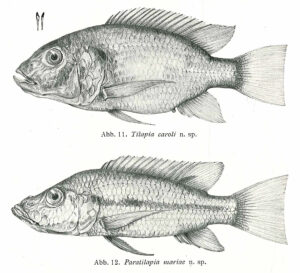
From: Holly, M. 1930. Synopsis der Süßwasserfische Kameruns. Sitzungsberichte, Akademie der Wissenschaften in Wien, Mathematisch-Naturwissenschaftliche Klasse v. 139 (Abt. 1) (nos. 3-4): 195-281, Pls. 1-2.
3 August
Max, Maria and Karl
Austrian zoologist Maximilian Holly (1901-1969) is the author of 46 species-group names from 10 fish families and the author of four generic names (two of them still valid today). Among these names are three eponyms we could not figure out. Now, thanks to a recent paper by ichthyologist Nina Bogutskaya and five colleagues, “An annotated catalogue of the type specimens described by Maximilian Holly housed in the Natural History Museum of Vienna Part 1 Chordata Actinopterygii and Echinodermata Asteroidea,” we can shed more etymological light on these three names.
We previously encountered Holly in an early Name of the Week (5 March 2014). “We’ve seen fish taxa named after spouses, siblings and children,” we wrote. “But this is the first one we’ve seen named in honor of a … mother-in-law!” Holly named that bagrid catfish genus Sperata in honor of his late mother-in-law Maria Adolfine Sperat, who had supported Holly’s studies with “great understanding” or “sympathy” (depending on how one translates the German text).
In 1926, Holly described a cyprinid from Cameroon, Varicorhinus (now Labeobarbus) mariae. He did not say for whom he named the species. In 1930, he named a cichlid, Paratilapia (now Stomatepia) mariae, also from Cameroon. Again, he did not identify the honoree. Initially, we guessed that these two fishes, like the genus Sperata, were named for mother-in-law Maria Adolfine Sperat. But now, thanks to Bogutskaya et al., we know that Holly’s wife was also named Maria (née Sperat). Our guess is that Holly shared the love between the two most important women in his life. His wife for the cyprinid and cichlid. His wife’s mother for the catfish.
Holly described another Cameroonian cichlid in 1930, Tilapia (now Sarotherodon) caroli. This one had us stumped. Who was Carol? We had no idea. “Patronym not identified,” we wrote, “nor can identity be inferred from available information.” But we overlooked the fact that “Carol” is from “Carolus,” the Latin spelling for Charles, Carl and Karl. According to Bogutskaya et al., Sarotherodon caroli is almost certainly named for German physician, anthropologist and natural history collector Karl Albert Haberer (1864-1941), who provided the Cameroonian fishes that Holly described.
One name coined by Holly remains a mystery. In 1928 he described Barbus (now Labeobarbus) matris, a relative of Labeobarbus mariae from Kenya. “Matris” is the Latin genitive singular of māter, meaning mother. Was Holly referring to his own mother, his mother-in-law, or the mother of his children (assuming he had any)?
Bogutskaya and her coauthors promise a follow-up paper detailing Holly’ personal life and career. Maybe the answer to “matris” lies in there.
27 July
Subterranean names
Fishes that live underground often inspire interesting names. A few examples:
The Cuban Cusk-eel (Bythitidae) Lucifuga subterranea Poey 1858 lives in the anchialine caves, sinkholes and crevices of Cuba. Its genus name, also coined by Poey, is a combination of the Latin lux, meaning light, and fugio, to flee, fly or take flight — i.e., fleeing light — referring to its subterranean (and therefore lightless) habitat.
Aspidoras mephisto Tencatt & Bichuette 2017 (Callichthyidae) is described from Anésio III cave in the Tocantins River basin of Goiás, Brazil. Its name refers to Mephistopheles, a demon from German folklore (me-, not; phos, light; philis, loving, i.e., not liking light). This catfish is the first troglobitic species known from its family (famous for the Corydoras catfishes popular in the aquarium trade).
The netherword of Hell is evoked in the next two names.
Ophisternon infernale (Hubbs 1938) is a blind swamp eel (Synbranchidae) that inhabits freshwater in sinkholes and limestone caves in the Yucatán Peninsula of Mexico. Its specific name is from the Latin infernalis, of or belonging to the world or “regions” below the surface of the Earth — i.e., to the realm of the dead in ancient mythology, or the abode of evil spirits in Jewish and Christian belief.
The most-famous denizen of Hell, the Prince of Darkness, is evoked in the genus name of the Widemouth Blindcat (Ictaluridae), Satan eurystomus Hubbs & Bailey 1947, known only from aquifers deep below San Antonio, Texas.
The netherworld of Greek mythology, Styx, is evoked in the names of Stygichthys typhlops Brittan & Böhlke 1965, a blind cave tetra (Characidae) from the Juíba karst aquifer of Minas Gerais, Brazil. The specific epithet typhlops — from typhlos, blind, and ops, eye —refers to the lack of any external evidence either of eyes or of circumorbital bones (except for one short isolated segment).

Pangio pathala. Photo by: C. P. Arjun. From: Sundar, R. L., C. P. Arjun, A. Sidharthan, N. Dahanukar and R. Raghavan. 2022. A new diminutive subterranean eel loach species of the genus Pangio (Teleostei: Cobitidae) from Southern India. Zootaxa 5138 (1): 89-97.
To this list we can add this recently described eel loach (Cobitidae) from India: Pangio pathala Sundar, Arjun, Sidharthan, Dahanukar & Raghavan 2022 (shown here). Its specific name comes from the Sanskrit pâtâla, meaning “below the feet,” referring to its subterranean habitat. The loach was collected from an overhead water-storage tank connected to an old dug-out well at a house in Thiruvanvandoor, Chengannur, Kerala, India.
As reported in The Wire, an Indian nonprofit news and opinion website, the owner of the house was taking a shower when he felt a “thread-like” thing fall from above. When he looked down, the “thread” moved. The owner placed the wriggling creature — barely the length of his little finger — in a small glass jar filled with tap water. Then he called researchers at Kerala University in Kochi who had been conducting workshops and door-to-door awareness campaigns about subterranean fishes in the area since 2017. The researchers found three more specimens in the 17-foot well that supplied water to the shower.

Head of Denticeps clupeoides showing the dermal denticles that give the genus its name. From: Clausen, H. S. 1959. Denticipitidae, a new family of primitive isospondylous teleosts from West African fresh-water. Videnskabelige Meddelelser fra Dansk Naturhistorisk Forening, Kjøbenhavn 121: 141–151, Pls. 1–2.
20 July
Denticeps Clausen 1959
Of the 42,382 descriptions of new-fish taxa I’ve researched to date, this one is unique. But first, some contextual background to set the stage.
No two groups of animals can have the same genus-level name. Before proposing a new genus, a taxonomist would ideally review the literature to make sure that the new name isn’t “preoccupied.” This is fairly easy nowadays with the availability of online databases and the digitization and searchability of even the rarest, most obscure publications. But it was difficult if not impossible in pre-Internet times. There was simply no practical way for a specialist working on, say, nematode worms, to know every name proposed for, say, trilobites from the Paleozoic. When a preoccupied name (the junior homonym) is discovered a replacement name is proposed, often by a taxonomist working decades after the latter name was published. When this happens, the name of the original taxonomist is often no longer linked with the genus he or she discovered or revealed as unique.
Which brings us to Danish ichthyologist H. Stenholt Clausen (1921-2002). In 1959, he published a major discovery among fishes, the existence of a new and morphologically primitive herring-like fish from the freshwater waters of western Nigeria. He named it Denticeps clupeoides. He also proposed a new family for it, Denticipitidae. The genus name is a combination of dentis, Latin for tooth or denticle, and ceps, Latin for head or headed, referring to the extensive extra-oral teeth (dermal denticles) covering most of the head. The species name is from the Greek suffix –oides, meaning like, resembling, or having the form of, and the Latin clupea, a herring or herring-like fish, referring to its “decidedly herring-like” appearance, behavior and movement.
Maybe Clausen wasn’t sure about the uniqueness of the name “Denticeps.” Or maybe he just wanted to make sure his name was always linked to the genus (and family) he discovered. Because he did something I have not seen in any other fish description: He proposed an alternative or back-up name in case “Denticeps” is ever found to be a homonym. That name is Igborichthys, i.e., the fish from Igboro, referring to the village of Igboro, north of Ilaro, in the Egbada Division of Nigeria, near where the species was first found. Clausen also proposed a back-up name for the family: Igborichthyidae.
In other words …
Denticipitidae Clausen 1959 would become Igborichthyidae 1959
… and …
Denticeps Clausen 1959 would become Igborichthys 1959
… and …
Denticeps clupeoides Clausen 1959 would become Igborichthys clupeoides (Clausen 1959)
Whether he was being clever or just cautious, Clausen made sure that “Clausen” would always be linked to all of the fish’s names.
13 July
Ichthyocoris vs. Salariopsis revisited
For the 16 February 2022 “Name of the Week,” I explained how the authors of Salariopsis, a new genus of European combtooth blenny, had apparently overlooked an older available name, Ichthyocoris, thereby making the latter a junior synonym of the former. The editors of Eschmeyer’s Catalog of Fishes came to the same conclusion, as did the authors of a follow-up paper. Earlier this month, the authors of Salariopsis — Vecchioni et al. — published a new paper in which they present evidence that Ichthyocoris is actually a junior synonym of Salaria and that Salariopsis is valid as proposed.
Ichthyocoris was proposed by French biologist Charles Lucien Bonaparte in 1840. At this time, the practice of assigning a type species — i.e., the exemplar of the genus and permanently taxonomically associated with it — was not yet a common nor required practice among ichthyologists. (The type species concept was introduced by entomologist Pierre André Latreille in 1810.) In such cases, later ichthyologists would designate a type species, as American ichthyologist David Starr Jordan did in 1919. In his classic work The Genera of Fishes, Jordan designated Salarias varus Risso 1826 as the type species of Ichthyocoris since the genus was proposed in Bonaparte’s account of that species (as Blennius varus). Salarias varus is now considered a junior synonym of Blennius fluviatilis Asso y del Rio 1801, which the authors of Salariopsis designate as the type species of their new genus. I and others maintained that since Ichthyocoris is permanently fixed to Salarius varus, which is the same as Blennius fluviatilis, then Ichthyocoris has priority over Salariopsis.

Salaria pavo, male, from the Black Sea. Photo by George Chernilevsky, courtesy Wikipedia.
In their follow-up paper, Vecchioni et al. claim that Jordan made a mistake in designating Blennius fluviatilis as the type species of Bonaparte’s Ichthyocoris. Instead, they say, Bonaparte “explicitly stated that the type species of Ichthyocoris is Blennius pavo,” not B. fluviatilis. I checked Bonaparte’s description and found this passage in his account of Blennius varus, a passage that Jordan apparently overlooked:
“Tipo infatti di questo nostro genere è il Blennius pavo …”
Dr. Vecchioni’s translation (pers. comm.) is “Type in fact of this our genus [Ichthyocoris] is Blennius pavo …”
Is this an explicit type-species designation? Personally, I am not convinced. Could “tipi” simply mean “type” in the general sense (i.e., a kind, species or variety) and not the technical term “type species”? (Alternate translation: “In fact, a kind of this genus of ours is Blennius pavo …”) Also, I am not convinced that Bonaparte was familiar with the type species concept.
According to Dr. Vecchioni, Bonaparte’s wording was reviewed by Maurice Kottelat and Alberto Ballerio, both members of the International Commission on Zoological Nomenclature (ICZN). They concluded that Bonaparte’s statement is “rigidly construed” as required by the ICZN Code (art. 67.5) and thus satisfies the modern criteria of a type designation.
Despite my doubts, I am left to trust the authors of the paper, three of whom are Italian and therefore are better qualified to translate a language I do not read. And to trust Maurice Kottelat, a well-respected ichthyologist who understands the Code as well as anyone. And to trust the editors of Eschmeyer’s Catalog of Fishes, who accept the findings of Vecchioni et al. and accept Blennius pavo as the type species of Ichthyocoris, a junior synonym of Salaria.
Since Blennius fluviatilis is no longer considered the type species of Ichthyocoris, it is available to be the type species of Salariopsis. I have emended the ETYFish entries, replacing Ichthyocoris with Salariopsis.
 6 July
6 July
Gobiobotia lii Chen, Wang, Cao & Zhang 2022
27 years of research, writing and production.
653 published volumes.
1,892 entries.
1,160 hand-drawn diagrams.
Nearly 2 million Chinese characters.
First published in 1593 (Ming Dynasty) and still published today.
Ben Cao Gang Mu (Compendium of Materia Medica) has been called the most comprehensive book ever written about traditional Chinese medicine. It lists, analyses and describes all the plants, animals, minerals, and other objects that were believed to have medicinal properties. In addition to folk medicine, it contains historical information on chemistry, geography, mineralogy, geology, history, mining, astronomy, animal husbandry, and biology. Charles Darwin cited it in his Origin of Species.
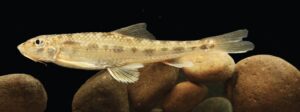
Gobiobotia lii, holotype, photographed alive immediately upon capture. From: Chen, X., M. Wang, L. Cao and E Zhang. 2022. Gobiobotia lii, a new species of gudgeon (Teleostei, Gobionidae) from the middle Chang-Jiang basin, central China, with notes on the validity of G. nicholsi Bănărescu & Nalbant, 1966. Zoosystematics and Evolution v. 98 (no. 1): 93-107.
And now the author of this famous work, Li Shi-zhen (1518-1593), has a fish named in his honor.
Gobiobotia lii is a new species of Eight-barbel Gudgeon from Lake Dongting and the middle Yangtze River basin of Hubei Province, China. The authors honored Li for two reasons: He’s was a native of Qichun County, where the holotype and some of the paratypes were collected. And the gudgeon’s barbels remind the authors of Li’s long beard.
Despite its nomenclatural pedigree, I doubt the gudgeon has any medicinal qualities.

Heterotis niloticus. From: Rüppell, W. P. E. S. 1829. Beschreibung und Abbildung mehrerer neuer Fische, im Nil entdeckt. Brönner, Frankfurt am Main. 1–12, Pls. 1–3.
29 June
Heterotis Rüppell 1829, not 1828
The following 880 words explain the correction of an “8” to a “9.”
Heterotis niloticus is the only species of arapaima — otherwise a South American family — native to Africa. (It’s commonly called the African Arowana but it’s actually an arapaima.) The generic name derives from the Greek heteros, meaning different, and the Greek otos, meaning ear, referring to the helically shaped suprabranchial (situated over the gills) organ on the fourth gill arch. This structure helps the fish, a plankton feeder, concentrate tiny food particles. The specific name niloticus means “of the Nile,” the type locality of the first specimens to reach Europe, collected by German naturalist Christian Gottfried Ehrenberg during an expedition to Egypt in the early 1820s.
While revising the Order Osteoglossiformes for the “new and improved” version of the ETYFish Project, I noticed an oddity in the dates of the names: the genus predates the type species by a year. According to Eschmeyer’s Catalog of Fishes, FishBase, Wikipedia, and other online references, the genus was dated to Rüppell 1828 whereas the species dated to Cuvier 1829. This sometimes happened among names proposed in the early days of zoological nomenclature, when criteria for “available” names had not yet been set and agreed upon. Sometimes a naturalist would give an animal a generic name without explicitly assigning a species, then a subsequent naturalist would “fill in the blanks” by formally naming one or more species in that genus. The Indo-Pacific fish genus Velifer hypselopterus is an example. The generic name dates to Temminck & Schlegel 1850, but the type species (and only species in the genus) dates to Bleeker 1879 — 29 years later! (This is not allowed today.)
Wondering if the same thing happened with Heterotis, I consulted the relevant literature. What I learned is that ichthyologists began debating the authorship of the species in the 1960s, even petitioning the International Commission of Zoological Nomenclature (ICZN) to settle the matter. The controversy stems from the fact that neither Rüppell nor Cuvier coined the generic and specific names. Instead, the full nomen “Heterotis niloticus” was proposed by the collector Christian Gottfried Ehrenberg, when he prepared a series of color plates for subsequent publication in a book about his zoological discoveries in Africa. These plates were printed in 1828 and unofficially found their way, unbound, to a few naturalists and museums between 1828 and 1899, when the complete work, with Ehrenberg’s text, was finally published. The title and date for the unbound plates were only on the carton that contained them. Some biologists consider these unbound plates as “published” and that taxa named on them should date to Hemprich & Ehrenberg 1828 (Hemprich was partner and collaborator Wilhelm Hemprich). Others argued that Ehrenberg’s plates were only privately shared as part of a work-in-progress, thus rendering any nomina proposed within unavailable. The ICZN decided to suppress the plates, making Hemprich & Ehrenberg 1828 an unavailable work for nomenclatural purposes. (Hemprich & Ehrenberg 1899, however, is available.)
Both Cuvier and Rüppell made no secret of the fact that Ehrenberg discovered the species and coined a manuscript name for it. In independent descriptions published the same year (1829), Cuvier and Rüppell retained the specific name (niloticus) but changed the generic name from Heterotis to Sudis, which Cuvier had proposed for arapaimas in 1816. (Unfortunately, neither naturalist realized that Cuvier’s Sudis was preoccupied by Sudis, a genus of aulopiform fishes proposed by Rafinesque in 1810.) Since Cuvier’s description appeared first, he is considered the author of the species — Heterotis niloticus (Cuvier 1829). Had Cuvier mentioned Ehrenberg’s Heterotis, he likely would have been the author of the genus as well. But he did not. Rüppell, on the other hand, did, calling Heterotis a junior synonym of Cuvier’s Sudis. In 1979, the ICZN ruled that Rüppell’s reference to Heterotis, although mentioned in synonymy, nevertheless represented the first mention of that name in the print, thereby making it the earliest available name to replace the preoccupied Sudis. Heterotis Hemprich & Ehrenberg 1828 was now officially Heterotis Rüppell 1829.
None of this explains why “Heterotis Rüppell 1829” became “Heterotis Rüppell 1828” in Eschmeyer’s Catalog of Fishes and many other contemporary references. A simple data-entry error appears to be the culprit. In late 1984, William Eschmeyer began assembling a database of fish names at the California Academy of Sciences. This database eventually became the Catalog of Fishes (renamed Eschmeyer’s Catalog of Fishes in 2019). At some point before 1990 (when the hardbound “Catalog of the Genera of Recent Fishes” was published), Eschmeyer or one of his assistants apparently entered the wrong publication in the database entry for Heterotis. That entry was part one (1828) of “Atlas zu der Reise im nördlichen Afrika. Fische des Rothen Meers” (“Atlas of the Voyage to Northern Africa. Fishes of the Red Sea”) when it should have been Rüppell’s 1829 “Beschreibung und Abbildung mehrerer neuer Fische, im Nil entdeckt” (“Description and illustration of several new fishes discovered in the Nile”). An easy enough mistake to make, but one that has gone unnoticed until now.
If anything, this error demonstrates the reach and influence of Eschmeyer’s Catalog of Fishes (ECoF). With over 71,800 entries encompassing over 39,300 publications, it’s understandable that a few data-entry errors slip their way in. This particular mistake will be corrected and posted at ECoF in early August. A revised ETYFish entry will be posted soon.
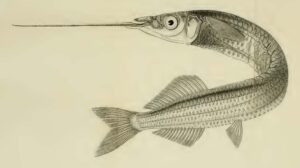
Rhynchorhamphus georgii. From: Cuvier, G. and A. Valenciennes. 1847. Histoire naturelle des poissons. Tome dix-neuvième. Suite du livre dix-neuvième. Brochets ou Lucioïdes. Livre vingtième. De quelques familles de Malacoptérygiens, intermédiaires entre les Brochets et les Clupes. P. Bertrand, Paris. v. 19: i-xix + 1-544 + 6 pp., Pls. 554-590. [Valenciennes authored volume.]
In honor of “George” Dussumier
Achilles Valenciennes named 24 fish species and one genus after Jean-Jacques Dussumier. He called Dussumier his friend yet, inexplicably, he gave Jean-Jacques’ first name as George. I don’t know why.
Jean-Jacques Dussumier (1792-1883) was a French ship owner and merchant who made at least 11 commercial voyages between 1816 and 1840 in the Indian Ocean as far as the China seas. In each port of call he made valuable zoological collections, which he gave to the Muséum National d’Histoire Naturelle in Paris, along with descriptive notes and drawings made from nature. For the air-breathing (and “walking”) catfish Clarias dussumieri Valenciennes 1840, Valenciennes mentioned that Dussumier observed this catfish in India, noting how it can “live long out of water, and crawl great distances” (translation). And for the round herring genus Dussumieria Valenciennes 1847, Valenciennes thanked Dussumier for the “sacrifices he made with great zeal in the service of ichthyology,” and remarked how, from his notes, “information we learn from one species in the Indies is comparable to what we learn from our European sardine” (translations).
For most of the taxa that Valenciennes named after Dussumier, he gave his name as “M. Dussumier,” the “M.” being the abbreviation for the French “Monsieur.” Forgoing the first name and using the honorific “M.” was a common practice among French zoologists of the time. But in 1847, Valenciennes decided to switch things up.
On page 33 of the 19th volume of his “Histoire naturelle des poisons,” Valenciennes described Hemiramphus (now Hyporhamphus) dussumieri, a halfbeak from the Seychelles. He credited “M. Dussumier” for providing a specimen 12.5 inches long.
A few pages later (37), he described another halfbeak, Hemiramphus (Rhynchorhamphus) georgii, from off the coast of India. Valenciennes wrote: “M. Dussumier, whose name has already been given to one of our new species [the one on page 33], has brought back several others from this great expedition devoted in part to ichthyology; I still want to dedicate this one to the memory of this zealous collector by designating it by his first name …”. “Georgii” means “of George.”
Later in the same volume (page 136), Valenciennes described the flyingfish Exocoetus georgianus (now a junior synonym of E. monocirrhus Richardson 1846). Valenciennes was unambiguous for whom the name honors: “It is also to my friend, George Dussumier, whose name returns with so much pleasure to my pen, that the Museum of Natural History owes the possession of this interesting species” (translation).
Was “George” a nickname for Dussumier? Was there another Dussumier, a brother perhaps, on the voyage? Or did Valenciennes actually believe Dussumier’s first name was George? Whatever the explanation, the Anglo-Saxon spelling — George, instead of the French Georges — is curious.
Dussumier signed his official correspondence to the Muséum National d’Histoire Naturelle as “J.-J. Dussumier.”

Monognathus bertini, holotype, 103 mm TL. From: Bertelsen, E., and J. G. Nielsen. 1987. The deep sea eel family Monognathidae (Pisces, Anguilliformes). Steenstrupia 13 (4): 141–198.
15 June
Monognathus Bertin 1936
If you were to name a new species of Monognathus — the only genus of the deep-sea eel family Monognathidae — you would face a choice: Continue a decades-long tradition or be a rebel and go against it.
The tradition is this: All 15 described species of Monognathus are named after people. This is unique among fish families with at least six species.* Monognathus — from the Greek monos, one, and gnathos, jaw, referring to the absence of an upper jaw — usually occur at depths greater than 2000 m and thus are captured only incidentally in oceanic cruises. Specimens are therefore rare in museum collections, with only a small circle of specialists who have interest in and access to them.
Note that 8 of the 15 species are named for scientists who either collected holotypes or made specimens available to other researchers:
- Monognathus bruuni Bertin 1936 in honor of Danish oceanographer and ichthyologist Anton Frederick Bruun (1901–1961), who took part in the Dana fishery research cruises, during which holotype was collected
- Monognathus jesperseni Bertin 1936 in honor of Danish oceanographer Poul Christian Jespersen (1891–1951), who took part in the Dana fishery research cruises, during which holotype was collected
- Monognathus taningi Bertin 1936 in honor of Danish ichthyologist Åge Vedel Tåning (1890–1958), who took part in the Dana fishery research cruises, during which holotype was collected
- Monognathus herringi Bertelsen & Nielsen 1987 in honor of Peter J. Herring, Institute of Oceanographic Sciences (Wormley, England), who collected and preserved Monognathus material aboard Discovery cruises in the North Atlantic
- Monognathus nigeli Bertelsen & Nielsen 1987 in honor of British ichthyologist Nigel R. Merrett (b. 1940), Institute of Oceanographic Sciences (Wormley, England), who provided several specimens of Monognathus and was “very helpful” during the authors’ revision of the family
- Monognathus ozawai Bertelsen & Nielsen 1987 in honor of Japanese ichthyologist Takakazu Ozawa (Faculty of Fisheries, Kagoshima University), who “kindly” let the authors describe the only Japanese specimen of this “rare” genus
- Monognathus rosenblatti Bertelsen & Nielsen 1987 in honor of American ichthyologist Richard H. Rosenblatt (1930–2014), Scripps Institution of Oceanography, who “kindly” put monognathid material from Scripps at the authors’ disposal
- Monognathus smithi Bertelsen & Nielsen 1987 in honor of open-ocean ecologist Kenneth L. Smith, Jr., Scripps Institution of Oceanography, chief scientist during the cruise from which holotype was caught in the central North Pacific
Four of the names honor scientists who’ve studied monognathids (or apodal fishes, i.e., eels, in general):
- Monognathus bertini Bertelsen & Nielsen 1987 in honor of French ichthyologist Léon Bertin (1896–1954), Muséum National d’Histoire Naturelle (Paris), for his “pioneer contributions” to the systematics of the family
- Monognathus boehlkei Bertelsen & Nielsen 1987 in honor of the late James E. Böhlke (1930–1982), Academy of Natural Sciences of Philadelphia, for his valuable contribution to the study of apodal fishes
- Monognathus rajui Bertelsen & Nielsen 1987 in honor of ichthyologist Solomon N. Raju, Scripps Institution of Oceanography, for his contributions to the systematics of this “rare family” of fishes
- Monognathus berteli Nielsen & Hartel 1996 in honor of the late Erik (“Bertel”) Bertelsen (1912–1993), Danish fisheries biologist and ichthyologist, for his contribution to our knowledge of the Monognathidae and many other groups of deep-sea fishes
The remaining three — coined by the same scientist, Solomon N. Raju — are personal in nature.
- Monognathus ahlstromi Raju 1974 in honor of ichthyologist Elbert H. Ahlstrom (1910–1979), Southwest Fisheries Center, National Marine Fisheries Service, who critically reviewed Raju’s manuscript
- Monognathus isaacsi Raju 1974 in honor of oceanographer John D. Isaacs (1913–1980), Scripps Institution of Oceanography, “for his encouragement and for the award of a postdoctoral fellowship from his research funds during the tenure of this work”
- Monognathus jesse Raju 1974 in honor of Raju’s wife, Jesse [a noun in apposition, without the matronymic “ae”]
Should another monognathid species be discovered, I predict it will be named for Jørgen G. Nielsen (b. 1932) of the Zoological Museum of Copenhagen. He authored or co-authored the descriptions of 9 of the 15 species in the family. He’s due.
* The crestfish family Lophotidae has five currently valid species, each named after a person. However, one non-eponymic junior synonym is available.
8 June
Heteroconger chapmani (Herre 1923)
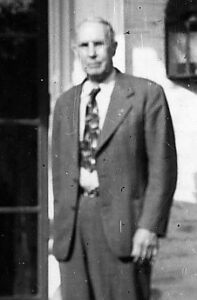
Undated photo of Dr. Chapman (he died in 1964).
When the Empire of Japan invaded the Philippines in 1942, Dr. Chapman and his wife refused to surrender. The myrmecologist grabbed his collection of ants and fled into the hills behind Dumagete, where he and his wife lived for the next two years, moving deeper and deeper into the jungle to escape detection from Japanese troops. The Chapmans were eventually captured in 1944 and interred at a Manila prison camp for 18 months until the Japanese surrendered to Allied forces in September 1945.
James Wittenmyer Chapman was born in 1880 in Ohio and raised on a farm. In 1916, with a Ph.D. from Harvard, he and his wife Ethel moved to the Philippines, where they worked as Presbyterian missionaries while Dr. Chapman taught biology at the Silliman Institute (now Silliman University). Ants were his passion. When he fled into the jungle, he buried his ant collection to protect it from the Japanese.
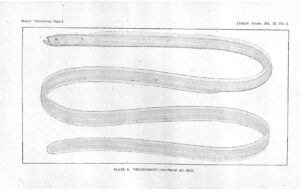
Holotype of Taenioconger (now Heteroconger) chapmani, from: Herre, A. W. C. T. 1923. A review of the eels of the Philippine Archipelago. Philippine Journal of Science v. 23 (no. 2): 123-236, Pls. 1-11.
At some point in the 1920s, Dr. Chapman crossed paths with Albert Herre (1868–1962), an American ichthyologist-lichenologist who served as the Chief of Fisheries of the Philippines Bureau of Science from 1919 to 1928. Herre named two fishes in honor of Chapman, a garden eel Taenioconger (now Heteroconger) chapmani in 1923, and a marine angelfish Holocanthus chapmani (now a junior synonym of Genicanthus lamarck) 10 years later. In the description of the angelfish Herre wrote: “I take pleasure in naming this species in honor of Dr. James W. Chapman, of Silliman Institute, Dumaguete, Oriental Negros, to whose generosity and enthusiastic assistance I am indebted for many rare and little known fishes.”
Dr. Chapman, a tall man of over 1.8 m, weighed only 54 kg. when rescued at the end of the war. He and his wife recuperated in the USA, and then returned to Dumagete, where they established a scholarship fund at Silliman University to help less fortunate young people obtain an education.
Upon his return to Dumagete, Dr. Chapman recovered his ant collection. It had miraculously survived the war.
1 June
The true meaning of Bagre?
EDITOR’S NOTE: This week’s entry — the 450th consecutive weekly NOTW — is written by Isaäc J. H. Isbrücker, a retired ichthyologist who specialized in the taxonomy of South American loricariid catfishes. Between 1960 and 1985, Dr. Isbrücker was an aquarist at the Amsterdam Zoo. He then became responsible for fish collection of the Zoological Museum in Amsterdam, which was transferred to the Naturalis Centre in Leiden in 2011. He authored or co-authored more than 120 publications between 1967 and 2017, in which he described roughly a dozen new fish species.

Page 174 from Marcgrave (1648) showing three unidentified (and anatomically incorrect) “bagre” catfishes.
Most sources tell you that the name of the catfish genus Bagre is derived from a Spanish or Portuguese word meaning “catfish.” I believe it’s from the Dutch bagger, meaning “mud” in English.
As a boy in elementary school, and already fond of fishes, I heard stories about exotic fishes told to me by Dutch sailors, fishermen and others who spent time at sea. Sometimes they spoke about catfishes they had encountered in tropical or subtropical areas of Africa, Asia and the Americas, which they called bagger or bagre. At the time I had no idea what a catfish was all about!
As far as I can tell, the first mention of bagre is in the famous work of Georg Marcgrave (to use one of the most common spellings of his last name), a German naturalist and astronomer (1610- c.1644), in his Historia Naturalis Brasiliae, posthumously published in 1648. Marcgrave and his coauthor, the Dutch physician Willem Pies (usually known as Piso, Latinized from Pies), both worked for the Dutch Brazil’s governor Johan Maurits van Nassau-Siegen from early 1638.
Bagre is mentioned seven times by Marcgrave. On the fifth mention (p. 174) he writes in Latin: “Bagre alia species: Belgis nostris vulgo Clipbagre [= Cliff bagre in English] decem digitorum longitudinem habet [etc.].” Cliff bagre is, as far as I know, no longer commonly used as a folk name for any catfish.
“Belgis” refers to Belgium, an independent country since 1830. But before that Belgium formed a unit with The Netherlands. Both the local names for these countries, België and Nederland, were used as alternate names for these two until 1830. I slowly became aware that bagre and bagger (still a common Dutch word meaning mud) must be closely associated. The catfish spp. called bagre by Marcgrave have the reputation, at least among the sailors with whom I spoke, to be at home on and near the bottom in the areas where they occur.
Bagre is not in modern Dutch dictionaries. Bagger is. In some English dictionaries, bagre is thought to allude to the back of some catfish, which I doubt is correct.
Even though it is impossible (for me) to prove that this issue is a true history, I strongly believe it is an acceptable explanation. Bagre became a Spanish and a Portuguese name for certain catfishes worldwide after Marcgrave’s famous book was published. In the Netherlands it is still informally used as a name for a wide array of catfishes, I guess mainly among mariners.
Bagre was used in 1766 by Linnaeus as the specific name for Silurus bagre, based on the published accounts of Mystus cirris quatuor of Gronovius (1763, also known as Gronow), the “Bagre” of Willoughby (1686), and the “Bagre tertia” of Ray (1713). Willoughby and Ray referred to Marcgrave, while Gronovius referred to Willoughby and Ray. Sometimes the world is not so big.
Cloquet 1816 (and Oken in 1817) used Bagre as the generic name for Silurus bagre, yielding the name combination Bagre bagre. The genus Bagre is the type genus of the current subfamily Bagreinae Schultz 1944 of the Ariidae Bleeker 1858.
A second family of Siluriformes, the name of which is a Latinization of Bagre, viz. Bagrus Bosc 1816, are the Bagridae Bleeker 1858.
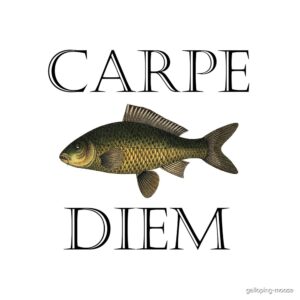 25 May
25 May
Cyprinus carpio Linnaeus 1758
Some fish names have been around so long, no one’s sure how they began and what they really mean. Take the scientific name of the Common Carp, Cyprinus carpio. Although the binomen scientifically dates to the starting point of zoological nomenclature, the 10th edition of Linnaeus’ Systema Naturae (1758), both parts of the name were in use for centuries.
Cyprinus is clearly a Latinization of kyprinos, Greek for carp, but what does kyprinos mean?
Two explanations have been proposed. Originally ETYFish reported that kyprinos is derived from Kypris, also known as Aphrodite, goddess of love, referring to the Common Carp’s fecundity. But earlier this year, Nicolas Bailly of FishBase sent me a fascinating paper on the Roman names of fishes that offers a different explanation: kyprinos may be derived from kuprinos, a Greek word for henna-like, referring to the carp’s bronze coloration (Guasparri, 2022). Both explanations are included in the online entry.
Where did carpio — and hence the vernacular “carp” — originate? Originally ETYFish reported that it is a Latinization of the Old French carpe. But Holger Funk, a Greek-Latin scholar who studies the history of early ichthyology, informed us that carpio is from the Latin carpa, which itself probably originated from an unknown Slavic language (Danube region) used by Germanic tribes and then the Romans (Petz-Glechner, 2005). Indeed, the same name appears in Romanic, Celtic, Germanic, and Slavonic languages, e.g., the Old High German charpho and the Middle Low German karpe.
I am intrigued by the fact that carpio is similar to the Greek karpos, meaning fruit. In Greek mythology, Karpos was a youth renowned for his beauty. He is the son of Zephyros (the west wind) and Chloris (spring, or new vegetation), forming a natural metaphor — the west wind heralds the new growth of spring, which then bears fruit. Carpophagous is fruit-eating. Carpology is the study of fruits and seeds. The Latin aphorism “Carpe diem” literally means “pluck the day.”
As suggested by the “Kypris” interpretation of “Cyprinus” noted above, the carp is indeed a fecund (fruitful) fish.
Connection or coincidence?
REFERENCES
Guasparri, A. 2022. The Roman classification and nomenclature of aquatic animals: an annotated checklist (with a focus on ethnobiology). Anthropozoologica 57 (2): 19-100.
Petz-Glechner, R. 2005. Die Namen unserer Fische—eine etymologische Spurensuche. 9. Karpfen. Österreichs Fischerei 58: 27–28.
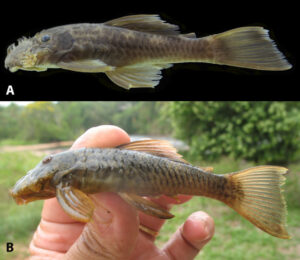
(A) Preserved specimen of Ancistrus luzia. (B) Specimen in life. From: Neuhaus, E. B., M. R. Britto, J. L. O. Birindelli and L. M. Sousa. 2022. A new species of Ancistrus (Siluriformes: Loricariidae) from Tapajós and Xingu basins, Brazil. Neotropical Ichthyology 20 (1): e210129: 1-21.
18 May
Ancistrus luzia Neuhaus, Britto, Birindelli & Sousa 2022
At 11,500, she is the oldest person honored in the name of a fish.
She is Lapa Vermelha IV Hominid 1 — nicknamed Luzia — a female Homo sapiens skeleton and one of the oldest human remains found in the Americas. Archaeologists discovered her in a cave in the Greater Belo Horizonte region, in the state of Minas Gerais, Brazil, in 1974. Her nickname Luzia is an homage to the Australopithecus fossil Lucy.
Luzia stood just under 1.5 m tall. Her remains seem to indicate that she died when she was approximately 20 years old, either in an accident or as the result of an animal attack. She was a member of a group of hunter-gatherers. Although flint tools were found nearby, hers were the only human remains found in the cave.
Luzia was displayed at the National Museum of Brazil until the museum was destroyed by fire on September 2, 2018. (See NOTW, 30 Dec. 2020, for details about the fire.) Luzia’s fossil was believed to have been destroyed also, but firefighters later discovered a human skull within the burned debris. On October 19, 2018, authorities announced that Luzia’s skull had been found, but in a fragmented state, as well as a fragment of her femur.
Ancistrus luzia, the fish, was discovered in 1994 by aquarium hobbyists among an import of fishes from Brazil and dubbed “L159,” using an alphanumeric code system to address undescribed (or at least unidentified) loricariid catfishes. It is distinguished from other members of the bristlenose catfish genus Ancistrus by its singular body color pattern, consisting of dark vermiculated stripes almost all over the body, and also by its narrow head, large internostril distance, and absence of rows of enlarged odontodes on the lateral plates. It occurs in the Tapajós and Xingu river basins of Brazil.
Brazilians were devastated by the loss of their beloved natural history museum. In naming the catfish after Luzia, the authors note that the recovery and reassembly of her skeleton has made her a “symbol of institutional hope and resilience.”
11 May
Beachcombing Fishes
One day you’re strolling along the beach minding your own business. A year or so later, a new species of fish is named in your honor. It’s happened several times.
Scymnodalatias sherwoodi (Archey 1921) In June 1920, a Mr. C. W. Sherwood of New Brighton, New Zealand, found a small (80 cm) shark washed up on a beach in Canterbury, New Zealand. He took it to the local museum, where it was identified as a new species of sleeper shark (Somniosidae) and named Scymnodon sherwoodi by Gilbert Archey, Assistant Curator of the Canterbury Museum. In 1965, shark biologist J.A.F. (Jack) Garrick designated the “Sherwood Shark” (as it’s sometimes called) as the type species of a new genus, Scymnodalatias.
Cubiceps baxteri McCulloch 1923 Lord Howe Island, in the Tasman Sea east of Port Macquarie, Australia, is a World Heritage site popular with hikers, birdwatchers, anglers, divers and snorkelers. R. E. Baxter, an amateur naturalist who lived on the island, found a fish stranded on the beach after a gale. He sent it to the Australian Museum, as he did with other plant and animals he collected. Although most of its scales were missing and its tail had detached from the body, ichthyologist Allan Riverstone McCulloch was still able to distinguish it as a new species of the driftfish (Nomeidae) genus Cubiceps. He named it in Baxter’s honor.
Ammodytoides renniei (Smith 1957) Kids love playing on the beach. And sometimes they find something new. William Smith (see NOTW, 22 May 2019) is the son of J.L.B. Smith, the famous South African chemist-turned-ichthyologist of coelacanth fame. One of William’s childhood friends was John Rennie of Grahamstown. During a Christmas holiday in which the Smith and Rennie families celebrated together, Rennie discovered three specimens of this sand lance “found on the beach after an onset of cold water, together with other valuable material,” including a dead 3 m-long oarfish. A younger John Rennie, along with his father Jack, appears in some of the group photographs of the second coelacanth captured in 1952.

Hexatrygon bickelli, holotype, female, 103 cm TL, dorsal (left) and ventral (right) views. From: Heemstra, P. C. and M. M. Smith. 1980. Hexatrygonidae, a new family of stingrays (Myliobatiformes: Batoidea) from South Africa, with comments on the classification of batoid fishes. Ichthyological Bulletin of the J. L. B. Smith Institute of Ichthyology No. 43: 1–17.
Ethadophis byrnei Rosenblatt & McCosker 1970 On 23 March 1967, John Byrne of San Diego, California, spotted a head sticking out of the wet sand on the beach during low tide at Puertecitos, Baja California Norte, Mexico. With the help of his friend Mark Aeder, Byrne grabbed the fish and brought it to the Scripps Institution of Oceanography, where it was identified as both a new genus and species of sand-burrowing snake eel (Ophichthidae) by John E. McCosker of the California Academy of Science. Sadly, Byrne passed away before McCosker’s description of the eel was published.
Hexatrygon bickelli Heemstra & Smith 1980 On 5 July 1980, during an evening stroll along the Summerstrand Beach in Port Elizabeth, South Africa, Dave Bickell noticed a “weird looking ray” lying dead on the tide line. An angling columnist for the Eastern Province Herald, Bickell knew the local fish fauna well and realized that the ray was quite unusual, with a hypertrophied snout and six gills (all other rays have five). He telephoned Malcolm Smale of the Port Elizabeth Museum, who put the specimen in 10% formalin and brought it to the J.L.B. Smith Institute of Ichthyology (now the South African Institute for Aquatic Biodiversity). Phillip C. Heemstra and Margaret M. Smith (wife of the late J.L.B. Smith) described the ray as a new genus and species in a new family, Hexatrygonidae. Dave Bickell was deservedly honored in the name.
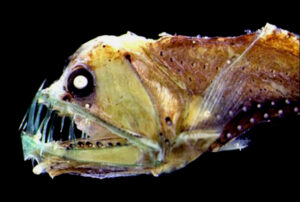
Chauliodus sloani. Courtesy: Wikipedia.
4 May
Chauliodus sloani Bloch & Schneider 1801
Do you drink chocolate milk? This mesopelagic dragonfish is named after its inventor, Hans Sloane.
I briefly mentioned Hans Sloane (1660-1753) in last week’s NOTW. He was an Irish physician-naturalist who sailed to Jamaica, then an English colony, in 1687. There and throughout the Caribbean, he collected or purchased more than 71,000 natural history specimens and artefacts. His “Natural History of Jamaica” (1725) is cited by many early ichthyologists, including Bloch & Schneider.
While in Jamaica, Sloane invented chocolate milk. He considered it an easier way to consume cocoa, then a common medicine. Upon his return to London, he sold his chocolate milk recipe to an apothecary, who in turn sold it to a little outfit called Cadbury, now the second largest confectionery brand in the world (after Mars).

Portrait of Hans Sloane from the Royal College of Physicians.
Today, historians are confronting Sloane’s role in what’s been termed the “scientific-slavery-industrial complex,” that is, the role slaves played in collecting natural history specimens from far-flung colonies, and how European naturalists, including Linnaeus, relied on slave ships for the transport of these specimens for their museums and private collections.
In Jamaica, Sloane worked as a doctor on sugar plantations. It was enslaved men, women and children, mostly from present-day Ghana and Cote d’Ivoire, who made these plantations profitable. Sloane documented the punishments these slaves endured without a trace of sympathy or regret. For rebellion, slaves were usually punished “by nailing them down to the ground … and then applying the fire by degrees from the feet and hands, burning them gradually up to the head, whereby their pains are extravagant.” For lesser crimes, castration or mutilation (“chopping off half the foot”) was the norm. And as for negligence, slaves “are usually whipt … after they are whipt till they are raw, some put on their skins pepper and salt to make them smart; at other times their masters will drip melted wax on their skins, and use very exquisite torments.”
Female slaves collected plants for Sloane. Some “cunning” (Sloan’s word) slave women used these plants to induce abortions in order to save their unborn children lives of bondage.
Sloane eventually married into the business and became a rich slave-owner himself. Using that wealth, he bought collections from other naturalists, and eventually amassed the largest collection of natural history specimens in the world, including human body parts (e.g., the “foetus of a negro from Virginia”). His collection formed the foundation of the British Museum. On the strength of his collection he became President of the Royal Society, the UK’s national academy of sciences, in 1727, taking over from no less a scientist than Isaac Newton.
In 2020, many expressed their outrage when the British Museum moved a bust of Hans Sloane off a literal pedestal and into a new display that explained his links to slavery. They charged the museum with “rewriting” and “erasing” history. But as British historian and broadcaster David Olusoga contends, it’s not Sloane who’s been erased from history. It’s the slaves, and the role slavery played in shaping the modern world, including modern science.
“Taking Sloane off his pedestal and setting him within historical reality is not an act of erasure,” Olusoga said, “it is a small act of recognition.”
27 April
Elops saurus Linnaeus 1766
There’s nothing lizard-like about the Ladyfish or Tenpounder, Elops saurus. Yet that is what its trivial name, saurus, means: Lizard. Why? The answer appears to be a case of mistaken identity. Or perhaps a clerical error by the Father of Taxonomy himself, Carl Linnaeus.
 In the case of Elops saurus, Linnaeus based his description in part on an illustration published in Hans Sloane’s Natural History of Jamaica (1725). Linnaeus cites the illustration (shown here): “Sloan. jam. 2. p 284. t. 251.” The abbreviation “t.” means “tabula,” i.e., a print from a plate rendered as full-page illustration in a book. As you can see, “t. 251” is captioned “Saurus maximus non maculatus” (“very large unspotted lizard”).
In the case of Elops saurus, Linnaeus based his description in part on an illustration published in Hans Sloane’s Natural History of Jamaica (1725). Linnaeus cites the illustration (shown here): “Sloan. jam. 2. p 284. t. 251.” The abbreviation “t.” means “tabula,” i.e., a print from a plate rendered as full-page illustration in a book. As you can see, “t. 251” is captioned “Saurus maximus non maculatus” (“very large unspotted lizard”).
Trouble is, “t. 251” does not show Elops saurus. Instead, it appears to show a lizardfish (Synodus). Indeed, the common name printed behind the dorsal fin, “Sea Galliwasp,” alludes to the Jamaica Giant Galliwasp Celestus occiduus, a lizard endemic to Jamaica.
 The true Elops saurus is illustrated on the previous page, “t. 250” (also shown here). As you can see, it’s clearly labeled “The Pounder.” Linnaeus apparently confused “t. 251” for “t. 250” and gave the unlizard-like fish the lizard name.
The true Elops saurus is illustrated on the previous page, “t. 250” (also shown here). As you can see, it’s clearly labeled “The Pounder.” Linnaeus apparently confused “t. 251” for “t. 250” and gave the unlizard-like fish the lizard name.
The meaning of the generic name Elops is also a mystery. Various sources suggest that the name is derived from the Greek elaúnō, to drive or set in motion, or that it’s etymologically related to swordfish. Neither explanation makes any sense when applied to the fish in question. My research indicates that elops is a Greek word variously defined as meaning a) dumb, b) scaly, c) a fish (in general), and d) a large, rare and precious fish compared to, or even identified with, the sturgeon (often spelled helops).
Considering that Linnaeus named E. saurus based in part on a 1725 description (“all over scaly”) of what appears to be a lizardfish, maybe the “scaly” explanation is the best fit.
20 April
Musical fishes
“The power of music lies in its ability to speak to all aspects of the human being — the animal, the emotional, the intellectual, and the spiritual. Music teaches us, in short, that everything is connected.” — Daniel Barenboim, pianist and conductor
Many ichthyologists enjoy connecting fishes with music. In previous NOTWs, we’ve met fishes named for Bach, Enya, Frank Zappa, Earl Scruggs, and Verdi’s Aida. Here are 10 more fish names (in chronological order) inspired in some way by music.
Citharinus citharus (Geoffroy St. Hilaire 1809) — The Latin cithara, from the Greek kithara, means harp, lyre or lute, hence the lutefishes of tropical Africa. The specific epithet refers to its conspicuous transverse scales rows, “nearly straight and parallel, which resemble the strings of a harp” (translation). The generic name Citharinus Cuvier 1816, meaning harp-like, continues the instrumental comparison.
Aspredinichthys tibicen (Valenciennes 1840) — The Latin tibicen means trumpeter, piper or flutist. Its use here refers to trompetter or trompetfisi (trumpeter), the Dutch-Surinamese local name for this and other banjo catfishes, alluding to the sound they make when taken out of the water (Isaäc J.H. Isbrücker, pers. comm.). It’s interesting that banjo catfishes (family Aspredinidae) have names that allude to different instruments.
Fistularia corneta Gilbert & Starks 1904 — “Corneta” is Spanish for cornet, a horn or small trumpet, hence the cornetfishes, a small family (Fistulariidae) of tropical marine fishes from the Atlantic, Indian and Pacific oceans. The name presumably refers to their horn-shaped mouth.
Ilyodon lennoni Meyer & Förster 1983 — This goodeid is named in honor of singer-songwriter John Lennon (1940-1980) of The Beatles. The authors do not explain why, but note that the description was published three years after Lennon’s murder, so perhaps his pointless death was still on their minds. (Note: some goodeid specialists treat I. lennoni as a junior synonym of I. whitei.)
Elacatinus figaro Sazima, Moura & Rosa 1997 — This goby from the Atlantic coast of Brazil is named for Figaro, the “smart and joyful” barber in Rossini’s opera The Barber of Seville (1816), referring to how this goby “cleans” parasites off the bodies of larger fishes. “Since barbers formerly acted as healers,” the authors wrote, “this name seems appropriate for a cleaner fish.”

A Gibson EDS-1275 double-neck guitar.
Lepidocephalichthys zeppelini Havird & Tangjitjaroen 2010 — This loach from Laos, Thailand and Vietnam is named for the rock band Led Zeppelin (1968-1980), specifically referring to the Gibson EDS-1275 double-neck guitar played by Jimmy Page, which reminded the senior author (who was listening to Led Zeppelin when working on the description) of its double (as opposed to single) lamina circularis — the bony process or plate at the base of the first (unbranched) and second (first branched) ray of the pectoral-fin in most male specimens of the family Cobitidae. (See C and D of the photo shown here.)

Lepidocephalichthys zeppelini, showing (C) lamina circularis on pectoral-fin, and (D) medial view of pectoral-fin removed from paratype showing lamina circularis. From: Havird, J. C., L. M. Page, W. Tangjitjaroen, C. Vidthayanon, C. Grudpan and S. Udduang. 2010. A new species of Lepidocephalichthys (Teleostei: Cobitidae) with distinctive sexual dimorphism and comments on relationships in southern lineages of Cobitidae. Zootaxa No. 2557: 1-18.
Bythaelurus vivaldii Weigmann & Kaschner 2017 — In 2016, shark taxonomist Simon Weigmann named a new species of deepwater catshark Bythaelurus bachi after Johann Sebastian Bach (see NOTW, 29 March 2017). He told us he selected the name not for any Bach-like feature the shark might possess, but simply because he loves Bach’s music. The next year he described another member of the genus, B. vivaldii, in honor of Bach’s contemporary, “genius composer” Antonio Vivaldi (1678-1741). The name connects the similar Baroque styles of Bach and Vivaldi’s music with the close morphological similarities between the two sharks.
Capoeta shajariani Jouladeh-Roudbar, Eagderi, Murillo-Ramos, Ghanavi & Doadrio 2017 — This scraper (family Cyprinidae, subfamily Barbinae) occurs in the Tigris River basin of Iran. Its name honors Mohammad-Reza Shajarian (b. 1940), an “acclaimed” Iranian classical singer, composer and master of traditional Persian music.
Neoplecostomus watersi Silva, Reia, Zawadzki & Roxo 2019 — This catfish from Goiás, Brazil, is named for George Roger Waters (b. 1943), composer, singer and guitar player from the rock band Pink Floyd, “for his talent as [a] musician and social awareness around [the] world, [e]specially his brave concerns to Brazilian economic, social and politic[al] issues.”
Scleronema milonga Ferrer & Malabarba 2020 — Here’s another South American catfish with a musically flavored name. Milonga is a musical rhythm popularized in Argentina and Rio Grande do Sul (Brazil), both regions where this trichomycterid catfish can be found.
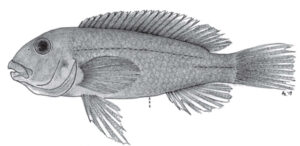
Steatocranus masalamasoso, holotype, 46.9 mm SL. Illustration by Alain Reygel. From: Ibala Zamba, A., J. D. Weiss, V. Mamonekene, U. K. Schliewen and E. J. Vreven. 2022. Steatocranus masalamasoso, a new species of lionhead cichlid from the Léfini River basin, Congo basin, Africa (Teleostei: Cichlidae). Ichthyological Exploration of Freshwaters IEF-1130: 1-11.
13 April
Steatocranus masalamasoso
The simile behind the trivial name of this new African cichlid is rather charming. Sadly, however, the species may already be extinct.
Steatocranus masalamasoso is — or should we say was? — a rheophilic cichlid known only described from the right bank of the Masala Ma Soso rapids on the Lower Léfini River, a right-bank tributary of the Middle Congo in the Republic of the Congo. The cichlid is named for the rapids. “Masala ma soso” means “chicken feathers.”
Why chicken feathers?
The name refers to the splashing and foaming water in the rapids. The sight of the water hitting the rocks reminded local inhabitants of a hen taking a dust bath!
The construction of a hydroelectric dam on the Léfini River, operational since 2009, inundated the Masala Ma Soso rapids. Recent efforts to collect S. masalamasoso failed, suggesting that adverse downstream effects of the dam may have led to the demise of this species.
The authors hope that the “Chicken-feather Cichlid” (my name, not theirs) still occurs in rapids upstream of the dam, but they’ve yet to be explored.
6 April
Two enigmatic names … explained!
I’ve often written about the enigmatic names coined by Australian ichthyologist Gilbert Percy Whitley (1903–1975). Some I figured out. Others I guessed at. Some I gave up on completely. Recently, I sent the unsolved Whitley names to Douglass Hoese, a Senior Fellow in the Ichthyology Collection of the Australian Museum Research Institute. He’s also a goby taxonomist, having described over 90 species. Dr. Hoese joined the Australian Museum in 1971, where he met and worked alongside Whitley during the final years of Whitley’s life.
“I once asked Whitley why he didn’t give derivations of names,” Dr. Hoese told me. “And he said that would be offensive to others, because everyone should know Latin grammar.”
But some of Whitley’s names go beyond Latin grammar. They’re true “headscratchers” with no obvious meaning or relevance to the fish in question.
Dr. Hoese solved two of these “headscratchers” for me. In retrospect, I should have figured them out on my own. All the clues were there in front of me.
Doryrhamphus malus (Whitley 1954) is an Australian pipefish that occurs from Mackay Reef to Masthead Islands on the Great Barrier Reef of Queensland. Malus is the Latin word for bad, evil, wicked, injurious, destructive, mischievous, hurtful, ill-looking, ugly, or deformed. Malus is also the genus of northern hemisphere apple trees. Neither meaning of the word makes any sense when applied to the fish. “Allusion not explained nor evident,” I wrote.
Dr. Hoese kindly pointed out that “malus” is also the Latin word for mast, and almost certainly refers to Masthead Island, the type locality.
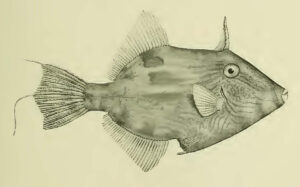
Paramonacanthus otisensis. From: Whitley, G. P. 1931. New names for Australian fishes. Australian Zoologist v. 6 (pt 4): 310-334, Pls. 25-27.
Paramonacanthus otisensis Whitley 1931, the Dusky Leatherjacket, occurs in weedy areas along the Pacific coast of eastern Australia. The Latin suffix –ensis means the name refers to a place, but Whitley did not mention a place named “Otis” or “Otise” in his description, nor could I find one on a map. I also asked some Australian fish people for help, but they were at a loss as well. Then Dr. Hoese came to the rescue:
Otis is the Latin (and Greek) word for bustard, a bird, Otis tarda, and almost certainly refers to either Bustard Head Lighthouse or Bustard Bay, Queensland, Australia, where several museum specimens (including possibly the holotype) were trawled in 1910.
“Whitley had a sense of humour and often used convoluted logic to derive his names,” Dr. Hoese told me. “Some having double meanings.”
True, but I should have cracked the etymologies of these two names myself.
30 March
H Geoffrey Moser (1938-2021)
I did not know that larval fish biologist H Geoffrey Moser* had passed away until reading the “Historical Perspectives” article about him in the most-recent issue of Ichthyology & Herpetology.
I won’t repeat what’s in the article. Written by Bruce C. Mundy and Eric J. Hilton, it’s a superb overview of Dr. Moser’s life and career, illustrated with many photographs. It’s open access (!), so please check it out. I will instead memorialize Dr. Moser by reviewing the three fishes to which his name is attached.
Although not primarily a taxonomist, Dr. Moser described two fishes. In 1969, he collaborated with his unofficial mentor Elbert Ahlstrom (1910-1979), director of the La Jolla California Current Resources Laboratory of the U.S. Fish and Wildlife Service Bureau of Commercial Fisheries, to describe a marine hatchetfish (Sternoptychidae) from the tropical eastern Pacific. They named it Araiophos eastropas, commemorating the EASTROPAC (Eastern Tropical Pacific Ocean Survey Cruise) expedition during which the type material was collected.

Thermichthys hollisi. © Ifremer. Courtesy of the Deep-water chemosynthetic species (CoML ChEss Project).
In 1990, Moser joined ichthyologists Daniel M. Cohen (1930-2017) and Richard H. Rosenblatt (1930-2014) to describe Bythites hollisi, now known as Thermichthys hollisi (shown here). This viviparous brotula (Bythitidae) occurs around hydrothermal vents at depths of 2,500 meters in the Galápagos Rift Zone of the southeastern Pacific. It’s named in honor of the “expert” Alvin submersible pilot Ralph Hollis, who “finally captured this elusive fish.”
One fish is named in Dr. Moser’s honor, the Whitespeckled Rockfish Sebastes moseri (Sebastidae), which occurs over rocky reefs from southern California south to the Pacific coast of northern Baja California. Blaise Eitner, a post-doc who worked in Moser’s lab, penned the description. He honored Moser for his “extensive” contributions to marine-fish biology and his many years of service at the U.S. National Marine Fisheries Service. And then he added:
“He is also a nice guy who loves rockfishes.”
* The absence of a period after “H” in H Geoffrey Moser is not a typo. “H,” and only “H,” is actually his given name, the first initial of both of his parents’ names. Which such an odd name, everybody called him “Geoff,” except for one colleague, who jokingly called him “Honly.”
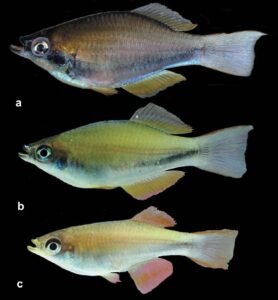
Plataplochilus eliasi, (a) male holotype, (b) male paratype, (c) female paratype. From: Walsh, G., P. H. N. Bragança and J. van der Zee. 2022. Plataplochilus eliasi (Cyprinodontiformes: Procatopodidae) a new species from the upper Noumbi River in the Republic of the Congo. Journal of Natural History v. 55 (no. 45/46): 2849-2867.
23 March
Plataplochilus eliasi Walsh, Bragança & van der Zee 2022
I don’t know the full story behind the naming of this fish. I am not going to ask the authors because the reason for the name is obviously deeply personal and private. It’s one of the saddest and yet most beautiful names among fishes.
The fish is a new species of lampeye (Procatopodidae) from the Republic of the Congo. This is the authors’ explanation of the name quoted verbatim:
In the naming of this species, we extend the sentiment of the Congolese tradition of the burying of a newborn baby’s placenta under a large tree in the child’s village of birth, representing a wish for growth, wisdom and strength for the child’s soul. The species is named for Elias Charly Arnaud Robert de Blic, a child no longer physically here, but remembered in this small fish in a forest stream, a space that is very much living and alive.
Curious, I did a quick search of the child’s name. Online records (ancestry.com) indicate that a baby of the same name was born 23 July 2013 in Parktown, Johannesburg, Provin, South Africa, and died that same day in France. That’s it. No other details.
I don’t know if it’s the same child, or even if the data is accurate. But that’s okay. I like the image of a small fish swimming in its forest stream, a “space that is very much living and alive.”
16 March
Isistius and Caristius
Smithsonian zoologist Theodore Gill proposed several genus-level names that include what appears to be a Greek word: istius. At least three ichthyologists have struggled to define what “istius” means.
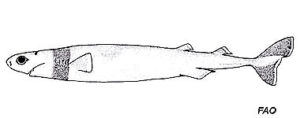
Isistius brasiliensis, showing its similarly sized and shaped dorsal fins (courtesy FAO).
Gill proposed the cookiecutter shark genus Isistius in 1865. He did not explain the etymology of the name. In his 2011 book The Sharks of North America, José I. Castro suggested that “Isistius” alludes to the Egyptian goddess Isis, represented in statuary with her head veiled, referring to the dark collar encircling the throat of I. brasiliensis, “which could also suggest a veil over the head” (p. 145).
In 1905, Gill (along with Hugh M. Smith) proposed Caristius japonicus, a new genus and species of manefish from Japan (now a junior synonym of C. macropus). In their 2013 revision of the genus, Duane E. Stevenson and Christopher P. Kenaley attempted to explain the meaning of “Caristius.” Like Castro, they evoked a mythological figure: “Presumably named after Carystus, a demi-god of Greek mythology.”
The true meaning of “istius” is far less god-like: It is simply a Latinization of the Greek histion, meaning sail, which in ichthyological nomenclature refers to the dorsal fin.
Isistius is likely a combination of isos, Greek for equal, and istius, from histion (Gr.), sail, referring to the two similarly shaped and sized (and posterior) dorsal fins of I. brasiliensis, a character Gill used to diagnose genus.
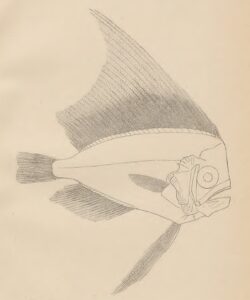
Caristius macropus, showing dorsal fin over the head and eyes. From: Bellotti, C. 1903. Di un nuovo Pteraclide Giapponese. Atti della Società Italiana di Scienze Naturali di Milano v. 42 (pt 2): 136-139, Pl. 6.
Likewise, Caristius is a combination of cara-, from the Greek kara, meaning top or head, plus histion, probably referring (quoting Gill and Smith) to its “high and elongated dorsal fin with the anterior rays crowded forward over the head and eyes.”
Gill used “istius” several times in generic names, all very likely referring in some way to the dorsal fin:
Acanthistius Gill 1862 — wirrahs (Serranidae) — acanthus, thorn or spine, perhaps referring to 13 dorsal-fin spines compared with eight as in Plectropomus, original genus of type species, A. serratus.Brachyistius Gill 1862 — surfperches (Embiotocidae) — brachys, short, presumably referring to shorter dorsal fin, with 8 vs. 9-10 spines in most related genera.
Dichistius Gill 1888 — galjoens (Dichistiidae) — dicho-, twofold or double, perhaps referring to distinctly different rayed and soft portions of dorsal fin of adults, with a deep notch between them; name could also refer to the nearly symmetrical soft dorsal and anal fins.
Goniistius Gill 1862 — morwongs (Latridae) — gonio-, angle, perhaps referring to the deeply notched (between spinous and soft portions) dorsal fin.
Iniistius Gill 1862 — razorfishes (Labridae) — inion, back of head, referring to position of first dorsal fin on nape of I. pavo.
Micromesistius Gill 1863 — blue whitings (Gadidae) — micro-, small and mesos, middle, referring to three dorsal fins, the middle one described by Gill as “short.”
Nematistius Gill 1862 — roosterfish (Nematistiidae) — nema, thread, referring to first dorsal fin, composed of eight very long filamentous spines.
Gill used “istius” in two specific names as well:
Brienomyrus brachyistius (Gill 1862) — an elephantfish (Mormyridae) — brachys, short, referring to its short dorsal fin.
Plagiotremus spilistius Gill 1865 — a combtooth blenny (Blenniidae) — spilos, spot or blemish, referring to numerous black spots on dorsal fin.
It was Theodore Gill who said: “The means for ascertaining or confirming the etymologies of many scientific names are, perhaps, not available for all who might desire to ascertain them, and they are often wrongly analyzed.”
We couldn’t agree more.
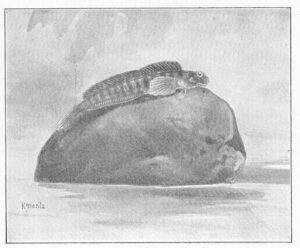
Alticus saliens. From: Jordan, D. S. 1907. Fishes. Henry Holt & Company, New York. i-xv + 1-789 + 18 plates.
9 March
Leapin’ Lizard Blenny!
“Leapin’ lizards!” is a catchphrase from the American comic strip “Little Orphan Annie” (1924-2010). Annie would certainly have uttered it had she seen the Leaping Blenny Alticus saliens, a tropical combtooth blenny (Blenniidae) from the Indo-West Pacific.
The Leaping Blenny is an amphibious fish that lives in the intertidal spray zone of lava rocks. They spend much of their time out of water, skipping and jumping from rock pool to rock pool like wet lizards. The lizard comparison dates to a 1777 account by Johann Georg Forster (1754-1794), a naturalist aboard the HMS sloop Resolution (1772-1775) during Captain Cook’s second voyage around the world. Forster observed a related blenny, now identified as Andamia amphibius (often confused with Alticus saliens) on what is now the island nation of Vanuatu:
We observed a great number of little fishes, not above two inches long, skipping about the wet rocks like lizards, to which they bore a great resemblance. Their pectoral fins performed the functions of feet, and their eyes were placed near the summit of the head, in order to guard them against all their enemies when they are out of the water. These little amphibious animals were indeed so cautious and so nimble at the same time, that it was with great difficulty we caught them. They could leap the length of a yard with great ease, and belonged to the genus of blennies. The same or a similar species of fish had been observed on the coast of New Holland [Australia] by captain Cook in the Endeavour. In one place we found them very active in destroying a brood of minute young crickets, which appeared to have been washed out of a crevice in the rock.
Both parts of the name of Alticus saliens refer to its “leapin’ lizard” behavior. “Saliens” is Latin for jumping or leaping. “Alticus,” also proposed by Lacepède, is derived from the French name l’altique sauteur, meaning “high jumper.”
Nomenclatural note: Some authorities (e.g., FishBase) credit authorship of the specific epithet to “Forster 1788.” We presume that publication is “Enchiridion historiae naturali inserviens,” written by Johann Georg Foster’s father Johann Reinhold Forster (1729-1798). We do not see a reference to “saliens” in the text.
2 March 2022
 Acipenser ruthenus Linnaeus 1758 –us, adjectival suffix: from Ruthenia, historic name for Ukraine and/or Belarus, probably referring to distribution in eastern Europe
Acipenser ruthenus Linnaeus 1758 –us, adjectival suffix: from Ruthenia, historic name for Ukraine and/or Belarus, probably referring to distribution in eastern Europe
Cobitis tanaitica Bacescu & Mayer 1969 –ica, belonging to: Tana or Tanais, ancient name for the River Don, Ukraine, type locality
Cobitis taurica Vasil’eva, Vasil’ev, Janko, Ráb & Rábová 2005 of Taurica, ancient Greek and Roman name for Crimea, referring to distribution in Crimean Peninsula, Ukraine
Barbus borysthenicus Dybowski 1862 –icus, belonging to: Borysthenes, ancient name for Dnieper River, referring to type locality in the Ukraine
Schizothorax zarudnyi (Nikolskii 1897) in honor of Nikolai Zarudny (1859-1919), Ukrainian-Russian explorer and ornithologist, who collected holotype
Gobio krymensis Bănărescu & Nalbant 1973 –ensis, suffix denoting place: southern Crimea, Ukraine, where it is endemic
Gobio sarmaticus Berg 1949 –icus, belonging to: Sarmatia, ancient name for territory corresponding to modern southern Russia, the eastern Balkans, and the distribution of this species in Ukraine
Romanogobio tanaiticus Naseka 2001 –icus, belonging to: Tanais, ancient name for Don River, Russia and Ukraine, where this gudgeon occurs
Alburnus sarmaticus Freyhof & Kottelat 2007 –icus, belonging to: the Sarmatians, a group of tribes that inhabited southern Russia, Ukraine and eastern Balkans from 5th century BC to 4th century AD, referring to distribution in Rivers South Bug and Danube (Bulgaria, Croatia, Romania, Slovenia, Ukraine)
Gaidropsarus pakhorukovi Shcherbachev 1995 in honor of Ukrainian ichthyologist Nikolay P. Pakhorukov, who collected holotype
Benthophiloides brauneri Beling & Iljin 1927 in honor of Ukrainian zoologist Aleksandr Aleksandrovich Brauner (1857-1941), who collected type
Ponticola odessicus (Pinchuk 1977) –ica, belonging to: Black Sea near Odessa, Ukraine, type locality
Ponticola ratan (Nordmann 1840) from Bitschok Ratan, local name used by Odessa (Ukraine) fishermen
Ponticola syrman (Nordmann 1840) derived from surman, a term used by Odessa (Ukraine) fishermen for P. cephalargoides but applied by Nordmann to this species
Gymnochanda ploegi Tan & Lim 2014 in memory of Dutch ichthyologist Alex Ploeg, a “good friend, fellow taxonomist, advisor and fellow conservationist against alien aquatic species; for his services to the ornamental fish trade in this region and abroad in his role as the Secretary General of the Ornamental Fish International” [Ploeg died, along with his wife and son and son’s friend, when Malaysia Airlines flight MH17 was shot down by a missile fired by pro-Russian rebels over Ukraine on 17 July 2014]
Afronandus sheljuzhkoi (Meinken 1954) in honor of Ukrainian-German entomologist Leo Sheljuzhko (1890-1969), one of the first aquarium amateurs and tropical-fish breeders in the Russian Empire, who collected type and sent specimens to Meinken
Crenicichla ploegi Varella, Loeb, Lima & Kullander 2018 in honor of Dutch ichthyologist Alex Ploeg, whose Ph.D. thesis dealt with the taxonomic revision, biogeography and phylogeny of Crenicichla, and who published papers on systematics of the genus from 1986 to 1991, describing a total of 23 species, 18 of which still considered valid; since then, he worked as interlocutor between the ornamental fish industry and other institutions worldwide, before losing his life (along with his wife and son and son’s friend) when Malaysia Airlines flight MH17 was shot down by a missile fired by pro-Russian rebels over Ukraine on 17 July 2014
Epiplatys chaperi sheljuzhkoi Poll 1953 in honor of Ukrainian-German entomologist Leo Sheljuzhko (1890-1969), who collected fish for Werner Aquarium importers (now called Transfish, Munich, Germany), including type of this one
Centrodraco gegonipa (Parin 1982) combination of the first two letters of both first and last names of Russian ichthyologist Georgy Golovan (GeGo) and Ukrainian ichthyologist Nikolay Pakhorukov (NiPa), who collected type specimens
Percarina maeotica Kuznetsov 1888 –ica, belonging to: Maeotis, ancient name for Sea of Azov (Russia and Ukraine), where it is endemic to eastern and northeastern watersheds
 23 February
23 February
Héctor Salvador Espinosa Pérez (1954-2022)
This week we report the sad news that one of Mexico’s leading ichthyologists succumbed to lung cancer on 20 February 2022. Born in 1954, Dr. Espinosa was curator of the Colección Nacional de Peces, Instituto de Biología, Facultad de Ciencias, Universidad Nacional Autónoma de México, Mexico City, Mexico. He was also a long-time member of the Desert Fishes Council and a dedicated fish conservation advocate. His taxonomic publications cover a wide range of species, including angel sharks (Squatinidae), blind cave tetras (Astyanax), mullets (Mullidae), and cichlids (Herichthys).
Dr. Espinosa was the co-author of two new species. The names of both species reflect a sense of cultural pride.
In 1990, he collaborated with German ichthyologist Manfred K. Meyer to describe Priapella olmecae, a poeciliid fish from the Atlantic slope of Veracruz, Mexico. The fish is named in honor of the Olmecas, the native people of southern Veracruz (where it occurs) and northern Tabasco.
In 1996, he and his Mexican colleague José Luis Castro-Aguirre (1943-2011) described Gobiesox juniperoserrai, a clingfish from Baja California Sur. They named it in honor of Junípero Serra, born Miguel José Serra Ferrer (1713-1784), a Jesuit missionary, evangelizer, and explorer of the Alta and Baja California region of Mexico where this clingfish occurs.
In addition, Dr. Espinosa served on the committee behind the sixth and sevenths editions of the American Fisheries Society’s Common and Scientific Names of Fishes from the United States, Canada, and Mexico. He was working on the eight edition at the time of his death.

Ichthyocoris varus (=fluviatilis). From: Bonaparte, C. L. 1840. Iconografia della fauna italica per le quattro classi degli animali vertebrati. Tomo III. Pesci. Roma. Fasc. 27-29, puntata 136-154, 10 pls.
16 February
Ichthyocoris, not Salariopsis
Ichthyocoris is now treaated as a junior synonym of Salaria and Salariopsis is now accepted as valid as described; see the 13 July entry above According to a new multi-locus phylogeny of the European combtooth blenny genus Salaria, three species should be removed from that genus and placed into a new one: Salariopsis. By adding the Greek noun opsis (meaning view or appearance) to Salaria, the new name highlights the “apparent, but misleading, morphological similarity to the blenniid genus Salaria Forsskål, 1775.”
However, it appears to us that Salariopsis has already been named.
When we entered “Salaria” in the genera field at Eschmeyer’s Catalog of Fishes (ECoF), we saw this entry:
Ichthyocoris Bonaparte [C. L.] 1840:fasc. 28 [Iconografia della fauna italica; ref. 514] Fem. Salarias varus Risso 1827. Type by subsequent designation. Type designated by Jordan 1919:206 [ref. 2410]. •Synonym of Blennius Linnaeus 1758 — (Bath 1973:519 [ref. 7212]). •Synonym of Salaria Forsskål 1775 — (Bath 1977:208 [ref. 208], Bath 1986:356 [ref. 6217], Bath 2003:95 [ref. 27343] as Icthyocoris). Current status: Synonym of Salaria Forsskål 1775
The “Current status” indicates that Salaria has a junior synonym: Ichthyocoris, proposed by French biologist Charles Lucien Bonaparte (1803–1857) in 1840. Bonaparte proposed the genus to accommodate Salarias varus Risso 1827, which was described by French naturalist Antoine Risso (1777–1845) in 1827.
When we entered “Salarias varus” into the species field at ECoF, we see that Salarias varus is a junior synonym of Blennius fluviatilis, proposed by Spanish diplomat-naturalist Ignacio Jordán Claudio de Asso y del Río (1742–1814) in 1801. This is important since Blennius fluviatilis is the type species of Salariopsis.
Here is where it gets tricky. Just because Ichthyocoris was proposed for a species (varus) that had already been described (fluviatilis) does not negate its nomenclatural potential. Ichthyocoris is permanently fixed to Salarius varus, which is the same as Blennius fluviatilis. Which means that Ichthyocoris is permanently fixed to Blennius fluviatilis also. Should Blennius fluviatilis ever justify being in a new genus, a name has already been proposed for it. Ichthyocoris.
The bigger lesson here is that junior synonyms are not “invalid” or “unavailable” names. They’ve simply been relegated to a kind of nomenclatural purgatory for taxa that have already been named. Most junior synonyms stay that way. But every year a dozen or so synonyms escape purgatory when they are revalidated or resurrected as “new” old taxa. (Or should that be “old” new taxa?) This usually happens when a taxonomist takes a fresh look at a museum specimen and discovers morphological differences that predecessors had overlooked and/or genetic evidence that the specimen in question represents a discrete evolutionary lineage and hence warrants recognition as a distinct (though closely related) taxon. If an older name is available, it gets dusted off and called into service. If an older name isn’t available, a new name is proposed. If the authors of Salariopsis had reason to dismiss Ichthyocoris, it’s not addressed in their paper. In fact. Ichthyocoris is not mentioned at all.
Our good friend Erwin Schraml, proprietor of the indispensable Welt der Fische / World of Fishes website, discovered the Ichthyocoris connection and reported it to ECoF. The editors of ECoF accept the phylogenetic conclusions of Vecchioni et al. but not their nomenclature. They list Salariopsis Vecchioni, Ching, Marrone, Arculeo, Hundt & Simons 2022 as a junior synonym of Ichthyocoris Bonaparte 1840:
Salariopsis Vecchioni [L.], Ching [A. C.], Marrone [F.], Arculeo [M.], Hundt [P. J.] & Simons [A. M.] 2022:7 [Diversity v. 14 (no. 1); ref. 38979] Fem. Blennius fluviatilis Asso y del Rio 1801. Type by original designation. •Synonym of Ichthyocoris Bonaparte 1840 by placement of type species. Current status: Synonym of Ichthyocoris Bonaparte 1840. Blenniidae: Blenniinae.
What does “Ichthyocoris” mean? Bonaparte did not tell us. “Ichthyos,” of course, means fish. “Coris” may be from the Greek korys, meaning helmet. Our guess is that “korys” alludes to the fleshy, conical crest on head of I. varus. According to Bonaparte, “The head, which occupies a fifth of the whole animal, is rather round, and presents above the adipose appendage formed by a protrusion of the same skin, extending from the orbit to the nape” (translation).
As seen in the illustration (shown above) that accompanied Bonaparte’s text, there is a fleshy crest on the head. With some imagination it resembles a helmet.
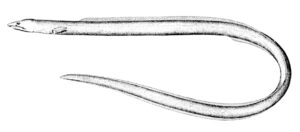
Ophichthus cruentifer. From: Goode, G. B. and T. H. Bean. 1896. Oceanic ichthyology, a treatise on the deep-sea and pelagic fishes of the world, based chiefly upon the collections made by the steamers Blake, Albatross, and Fish Hawk in the northwestern Atlantic, with an atlas containing 417 figures. Special Bulletin U. S. National Museum No. 2: Text: i-xxxv + 1-26 + 1-553, Atlas: i-xxiii, 1-26, 123 pls.
9 February
Ophichthus cruentifer (Goode & Bean 1896)
Last week we discussed the dangers of inferring a fish’s biology from a dead specimen in a jar, and how that can lead to an unfortunate name. Here’s another example.
In 1896, American ichthyologists George Brown Goode (1851-1896) and Tarleton H. Bean (1846-1916) described a new species of snake eel from coastal waters of the western North Atlantic. They named it Pisoodonophis (now Ophichthus) cruentifer. They said the specific name means “Sanguinary, cruel; in allusion to its habit of boring into the flesh of living fishes.”
Goode & Bean believed that the eel used its pointed tail to bore into and parasitize living fishes. As confirmation, they cited two specimens of the eel taken from the bodies of fishes caught by anglers.
A half-century later, ichthyologists began finding evidence that rejected Goode & Bean’s claim. In 1953, Charles Breder, Jr., of the American Museum of Natural History (AMNH), reported on a sea bass with a snake eel lodged in its coelom, the body cavity located between the intestinal canal and the body wall. Breder believed the sea bass had swallowed the eel, which then attempted to escape by “perforating the gut [with its sharp bony tail] and backing into the coelomic cavity where it finally expired.” In other words, the eel was trying to bore its way out rather than in. Breder suspected that Goode & Bean’s eels had died doing the same.
In 1955, Breder’s colleague at AMNH, Vladimir Walters, reviewed other cases of predatory fishes with snake eels stuck inside their bodies. He noted that all of the predators fed on or near the bottom, where snake eels live. In 1976, as part of his Ph.D. dissertation, Charles Wenner (College of William and Mary), reported how captive specimens of Ophichthus cruentifer used their bony tail to bury themselves tail first in the aquarium substrate. The eel was also observed in the wild, at 250-350 m deep, from the Deep Submersible Research Vehicle Alvin. The burrowing behavior was not observed, but the eels were seen with only their heads exposed from the sandy substrate.
In recent years, more cases of “pseudoparasitism” involving snake eels have been reported. In 2011, Isbert et al. reported snake eels in three common pandoras (Pagellus erythrinus) from the north-western Mediterranean, two in the stomach and one embedded in the body cavity. In 2020, Barton et al. reported snake eels from the body cavities of ten Australian fish species classified in eight different families, all of them medium to large, opportunistic carnivores, suggesting that the eels were targeted rather than incidentally ingested.
In fairness to Goode and Bean, their belief that Ophichthus cruentifer bores into the flesh of living fishes may have been influenced by an eel that actually does. In 1879, Theodore Gill described Simenchelys parasitica, a deep-sea eel from both the Atlantic and Pacific oceans. Gill reported specimens that had burrowed into the flesh of a halibut. Other accounts verify their boring predatory behavior. In 1992, for example, two S. parasitica were discovered inside the heart of a Shortfin Mako Shark Isurus oxyrinchus, where they had lived and fed for some time. The eels had apparently burrowed into the shark through the gills or throat, entered the circulatory system, and then made their way to the heart.
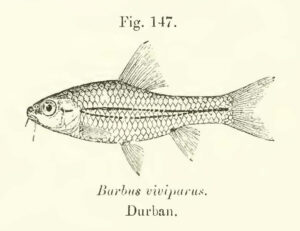
Barbus (now Enteromius) viviparus as illustrated in: Boulenger, G. A. 1911. Catalogue of the fresh-water fishes of Africa in the British Museum (Natural History). London. v. 2: i-xii + 1-529.
2 February
Enteromius viviparus (Weber 1897)
Many fishes are named for some aspect of their biology. How they eat, what they eat (and what eats them), how long they live, how they swim, what habitat they prefer, if and when they migrate, and so on. Such names presuppose that the describer has observed the fish in life (in an aquarium or ideally in the wild), but this isn’t always the case. Inferring behaviors from dead specimens in jars have led to a handful of unfortunate names.
For example, in 1897 German-Dutch zoologist Max Weber (1852–1937) named an African minnow Barbus (now Enteromius) viviparus. He claims he found 8-mm fry with yolk-sacs from the ovary of a 53-mm female, thus representing the first documented instance of viviparity (giving birth to live young) amongst an otherwise oviparous (egg-laying) group of fishes.
In 1943, South African zoologist Keppel Harcourt Barnard (1887–1964) set the record straight. He examined the specimens that Weber had collected. In one tube, Barnard found three females, all with normal ova, and several males, none of the them with the intromittent organ that distinguishes the males of viviparous poeciliids, such as guppies. In another tube, Barnard found a female from which the stomach and intestines has been removed but the ovary (with eggs) was nearly intact, and several fry with yolk sacs.
Fry from Pseudocrenilabrus philander, a mouth-brooding cichlid!
Barnard pieced together what probably happened. Weber had mentioned that he had obtained fry from the mouth of Pseudocrenilabrus philander at the same place he collected Barbus viviparus. Apparently, all these specimens were preserved together in the field, leading to Weber’s mistake when he examined them later in the lab. Why he claimed he found the fry in the ovary of the female cannot be explained.
Although a misnomer, the name remains nomenclaturally valid. There are lots of rules determining the availability and validity of scientific names in biology. Being biologically accurate is not one of them.
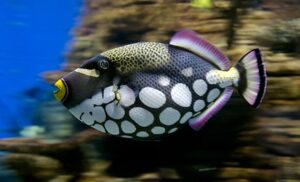
Balistoides conspicillum at uShaka Sea World Aquarium (Durban, South Africa), courtesy of Wikipedia.
26 January
Balistoides conspicillum (Bloch & Schneider 1801)
The Clown Triggerfish may be the most conspicuously colored fish in the world, but that’s not what its name — conspicillum — refers to. “Conspicillum” is Latin for lens or spectacles. Although Bloch & Schneider did not explain the meaning of the name, they did write “macula conspicilli formi[s] ante oculos,” which we translate as “spectacle-shaped marking in front of the eyes.”
Our guess is that the adjective refers to the broad stripe between the snout and eyes, like a pair of spectacles.
This begs the question: Why didn’t Bloch and Schneider (actually just Bloch, whose manuscript was edited and published by Schneider), name the Clown Triggerfish for any of its other, more conspicuous, markings. Why not the big white spots on the lower body? Or the yellow rim around the jaws? Or the black-and-yellow reticulations on the back behind the eyes? Or just the crazy, flamboyant combination of all these markings and colors?

“Baliste Américan.” From: Lacepède, B. G. E. 1798. Histoire naturelle des poissons. v. 1: 1-8 + i-cxlvii + 1-532, Pls. 1-25, 1 table.
The answer probably lies in the fact that Bloch never saw the fish in life. It appears that he based his description on a black-and-white illustration by Commerçon (shown here), identified as “Baliste Américan” under the mistaken belief that it occurred in America, published in the first volume of Lacepède’s Histoire naturelle des poisons (1798). Based on this lackluster rendering of an otherwise brilliant fish, it may be that to Bloch’s eyes its most interesting or intriguing feature was the white band positioned high on the snout, pinching the nose like a pair of pince-nez.
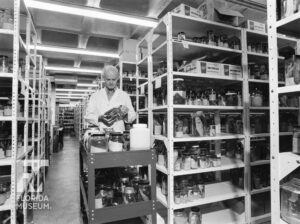
Dr. Gilbert at work in the Florida Museum of Natural History fish collection.
19 January
Carter R. Gilbert (1930-2022)
This week we mourn the passing of Carter R. Gilbert, who served as Curator of Fishes at the Florida Museum of Natural History from 1961 to 1998. Dr. Gilbert died on 6 January 2022 at the age of 91.
Dr. Gilbert was born in Huntington, West Virginia, and grew up in Columbus, Ohio. His father was a botanist, who no doubt nourished young Carter’s interest in natural history, and his mother spent a summer at Woods Hole, Massachusetts (future home of the Woods Hole Oceanographic Institute), where she met David Starr Jordan and got his autograph. Gilbert received his Ph.D. in zoology from the University of Michigan in 1960. During the year prior to graduation, he accepted a research position at the Smithsonian Institution, where his work involved a systematic revision of the hammerhead sharks. While engaged in this project he accepted a temporary position at the University of Florida in the spring of 1961, which shortly thereafter became a permanent position, first with the Department of Zoology and shortly thereafter with the Florida Museum of Natural History, during which time he rose through the academic ranks of Assistant, Associate, and full Professor.
His position at the University of Florida involved both teaching and research, of which the latter eventually resulted in over a hundred publications, mostly on North American freshwater fishes but also involving western Atlantic marine fishes and hammerhead sharks. Collection expeditions involved Mexico, Central and South America, various areas in the Caribbean and West Indies, as well as many of the 50 states.
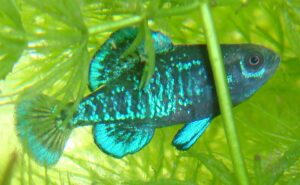
Elassoma gilberti male in full breeding colors (photo by Erica Wieser).
Over the course of his career, Dr. Gilbert described two new genera of gobies (Palatogobius and Vomerogobius) and either described or co-described 26 new species/subspecies, including cyprinids, cardinalfishes, toadfishes, and a troglobitic catfish (Prietella lundbergi). His most recent contribution was a 2017 revision (with Richard L. Mayden (of the North American cyprinid blacktail chub genus Macrhybopsis, including the descriptions of four new species.
Six species have been in Gilbert’s honor:
- Opistognathus gilberti Böhlke 1967, a jawfish from the Bahamas (Gilbert, who taught himself scuba diving, collected the holotype)
- Etmopterus carteri (Springer & Burgess 1985), a dwarf dogshark from the Caribbean coast of Colombia, for Gilbert’s 1967 revision of hammerheads
- Cirripectes gilberti Williams 1988, a combtooth blenny from Indonesia; Carter helped and encouraged Williams during the course of his revision of the genus
- Sicydium gilberti Watson 2000, a goby from the Dominican Republic; Watson honored Gilbert for contributing to our knowledge of fishes in the northwestern hemisphere, and for helping many other ichthyologists, including Watson
- Elassoma gilberti Snelson, Krabbenhoft & Quattro 2009, a pygmy sunfish from Georgia and Florida (USA), for his many contributions to the study of North American fishes and as “special thanks” from the first author for “serving as a guide and mentor for many years”
- Sphyrna gilberti Quattro, Driggers, Grady, Ulrich & Roberts 2013, a hammerhead shark described from off the coast of South Carolina (USA); it was Gilbert who first reported (in 1967) an anomalous specimen of S. lewini that is likely the first recorded individual of this species
From hammerheads to pygmy sunfishes — an impressive diversity of fishes to bear one’s name!
Several ichthyologists commented on Dr. Gilbert’s passing on social media. The word “gentleman” was used to describe him multiple times. Henry L. Bart, Jr., of Tulane University, wrote: “One of the grand gentlemen of Southeastern Ichthyology! Follow the currents, Carter, and take your place in that great school of minnows in the ethosphere!”
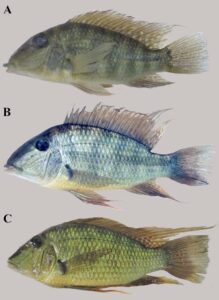
Fresh uncataloged specimens of Satanoperca setepele. A) Lajeado Reservoir. B) Rio Paranaíba. C) Upper Rio Paraná floodplain. From: Ota, R. R., G. de C. Deprá, S. Kullander, W. J. da Graça and C. S. Pavanelli. 2022. A new species of Satanoperca (Teleostei: Cichlidae) from the Rio Tocantins basin, Brazil. Neotropical Ichthyology v. 19 (no. 4) (art. e210116): 1-37.
12 January
Satanoperca setepele Ota, Deprá, Kullander, Graça & Pavanelli 2022
It’s become a custom for us to highlight the first-described new fish species of the New Year. For 2022 it is Satanoperca setepele.
Satanoperca are part of a group of South American cichlids known as “eartheaters” among aquarists for picking up mouthfuls of sand and sifting out items of food. This new species is described from the Rio Araguaia, Rio Tocantins basin, Brazil, with non-native records from the upper Rio Paraná basin.
The specific epithet “setepele” is from sete-pele, Portuguese for “seven skins,” a Brazilian name for a shape-shifting demon. The name alludes to the folklore surrounding the name of the genus (“demon perch”), inspired by the two first-named species of the genus, S. daemon and S. jurupari, from 1840. As explained in more detail in the NOTW for 3 January 2018, “jurupari” is derived from a local legend about three little boys who, seeking shelter from thunder in the forest, fled into the mouth of a spirit named Jurupari thinking it was a cave. Jurupari then visited the boys’ village, where he vomited the children, filling four baskets. The legend likely alludes to the mouthbrooding care of female Satanoperca, wherein fry retreat to their mother’s mouth for protection and are expelled when danger is past. Apparently, the natives were frightened by the fact that the young of these fishes were born from their mouths and thus regarded it as the work of the devil.
According to Eschmeyer’s Catalog of Fishes, 391 new fish species were described in 2021, just under the average of 404 new species described annually since 2002.
Technical note: An HTML version of the description of Satanoperca setepele appeared online in late 2021. But per the rules of the ICZN, the name is not available until its content is “fixed” (printed on paper or typeset in a PDF). The PDF of this description did not appear until after the first of the year, so it is dated to 2022.
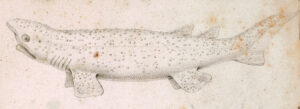
Echinorhinus brucus, holotype, adult female, 223 cm TL, illustrated in 1680 by Joseph-Guichard Du Verney and Philippe de La Hire. First published in: Iglésias & Mollen (2020), citation and link in text.
5 January
Echinorhinus brucus (Bonnaterre 1788)
When we first studied the etymologies of shark names back in 2009, we kind of gave up on this one. Echinorhinus brucus is a seldom-seen species that swims close to the bottom of the tropical and temperate oceans worldwide. It’s called the Bramble Shark because of the large, thorn-like dermal denticles scattered over its body. We took two guesses regarding the meaning of its name: (1) from the Greek brucus, heather, alluding to shark’s briar- or bramble like denticles and (2) from brux or bruchios, depths of the sea, referring to its deep habitat (400-900 m). We now recognize that the “heather” explanation is quite silly. The “depths of the sea” explanation is mentioned several times online. Both are wrong.
Had we dug a little deeper into the history of Bonnaterre’s original description of the shark, we likely would have figured out the true meaning of its name. Instead, we found the answer not through dogged etymological detective work, but because we recently found this fascinating paper online:
According to the authors, “brucus” comes from the Latin word brūchus or brūcus, itself taken from the Greek βροῦκος or βροῦχος, which means a “kind of wingless grasshopper (sauterelle)” or a “caterpillar (chenille).” What we had overlooked in our initial investigation is that “Chenille” or “Chenille de mer” (Sea Caterpillar) are local names (presumably among fishermen) for this shark along the Atlantic Coast of France (its type locality) in the 18th century. Simply stated: brucus = caterpillar.
We are not sure why the French called the Bramble Shark a “Sea Caterpillar.” Perhaps it’s an allusion to the shark’s thick, cylindrical body, which may appear caterpillar-like when the shark is flopping around or lying dead on a fisherman’s boat.
As for the generic name Echinorhinus, proposed by Blainville in 1816, it can be translated this way: echinos, Greek spiny or sea urchin, referring to the denticles on the body, and rhinus, an ancient name for sharks, from rhine (Greek for rasp), alluding to a shark’s jagged, rasp-like skin.